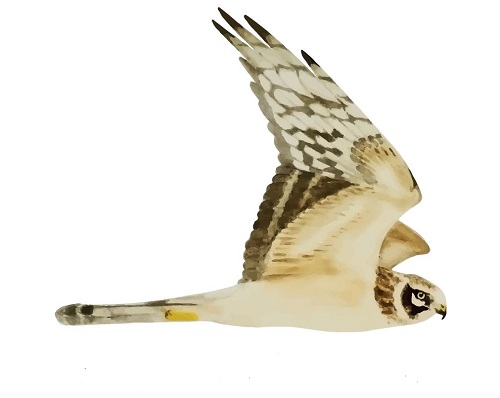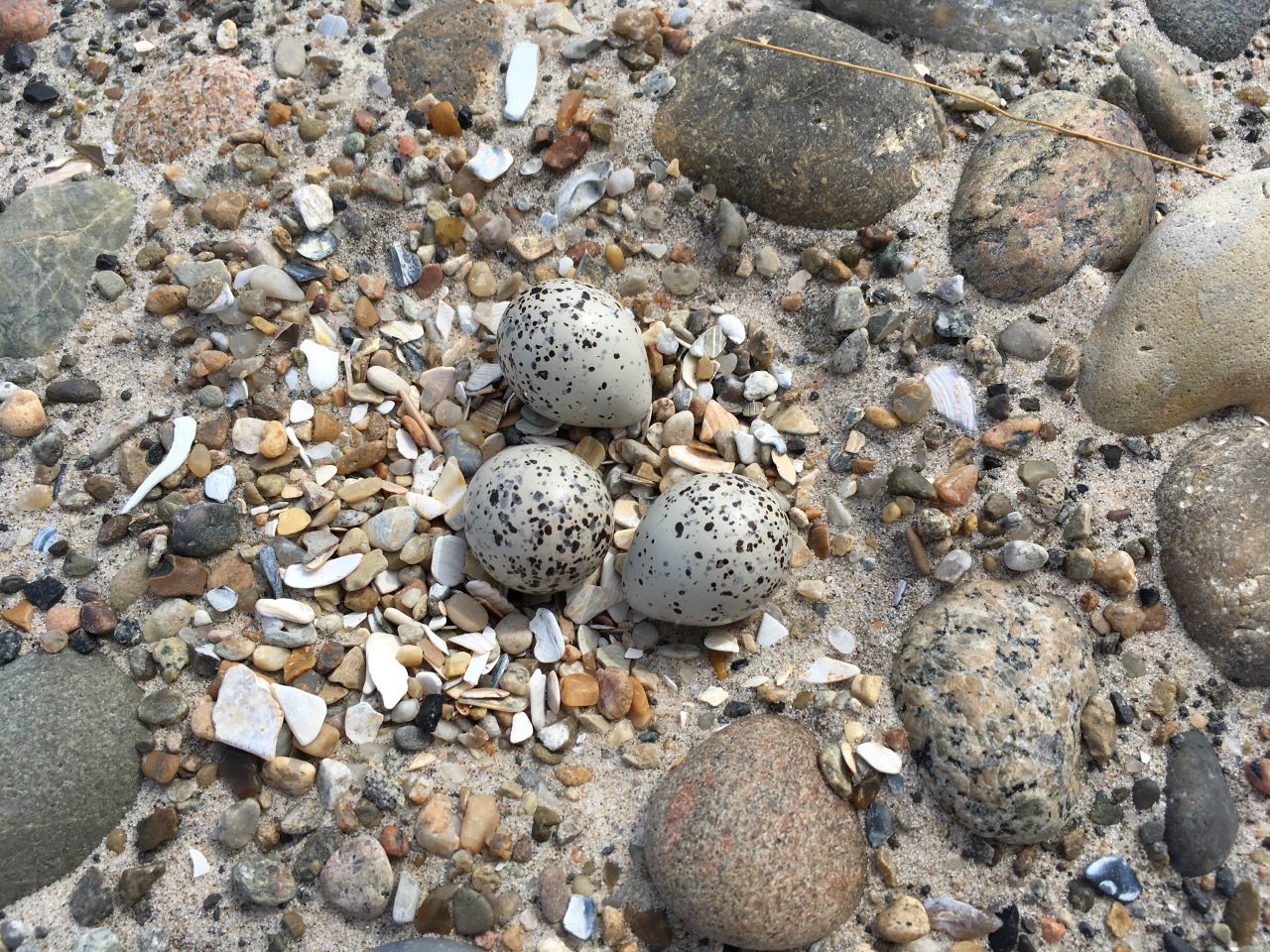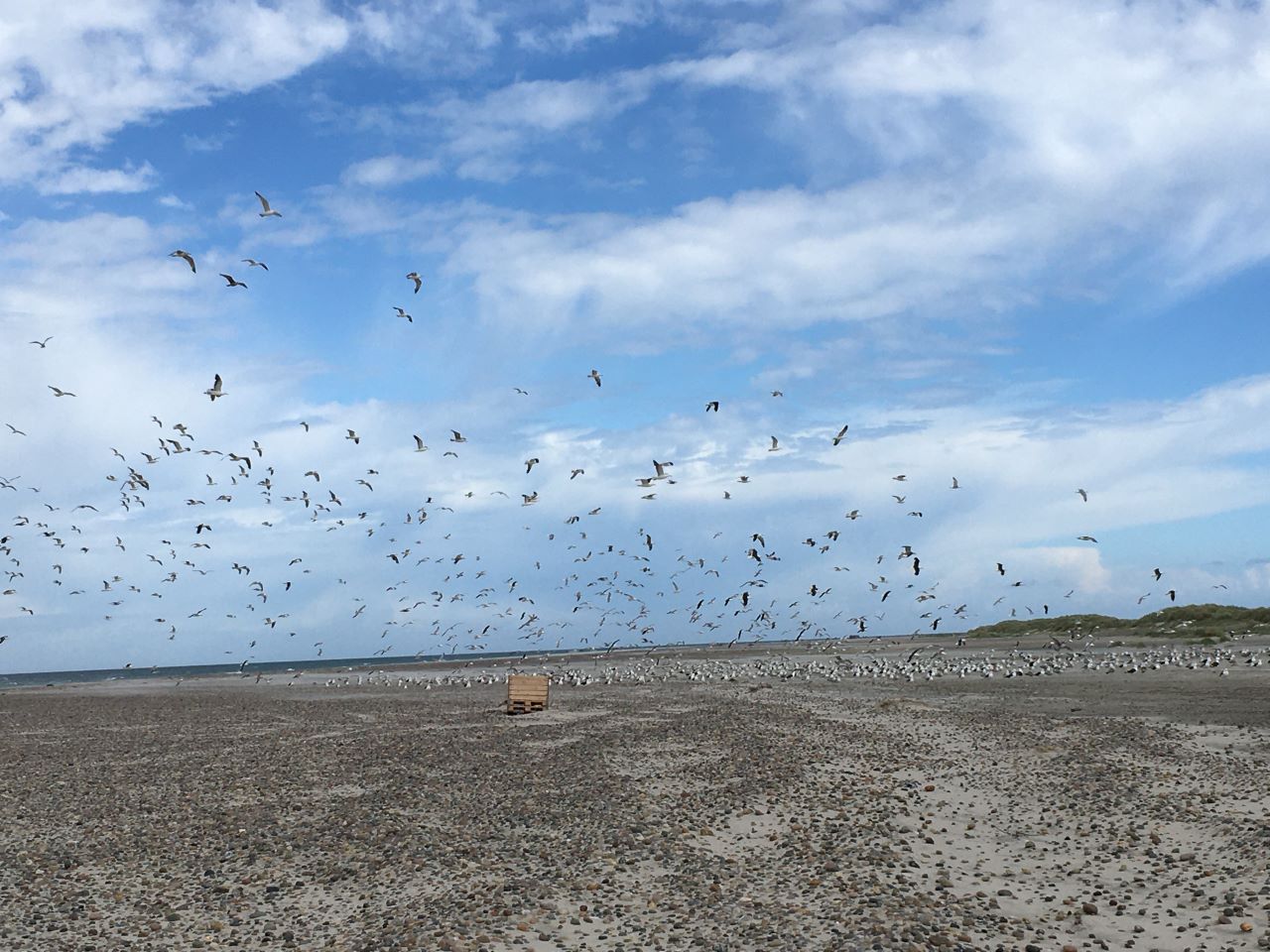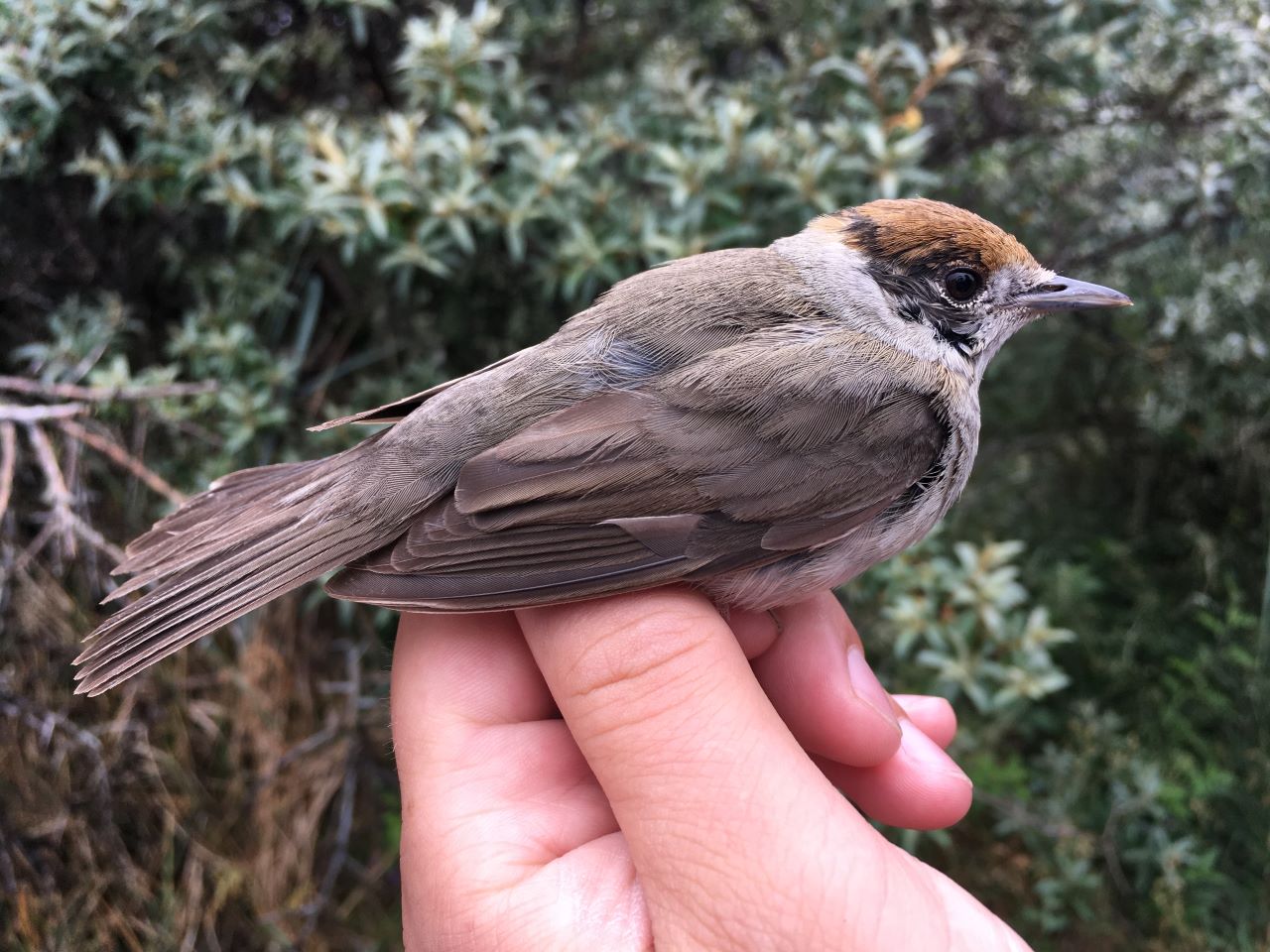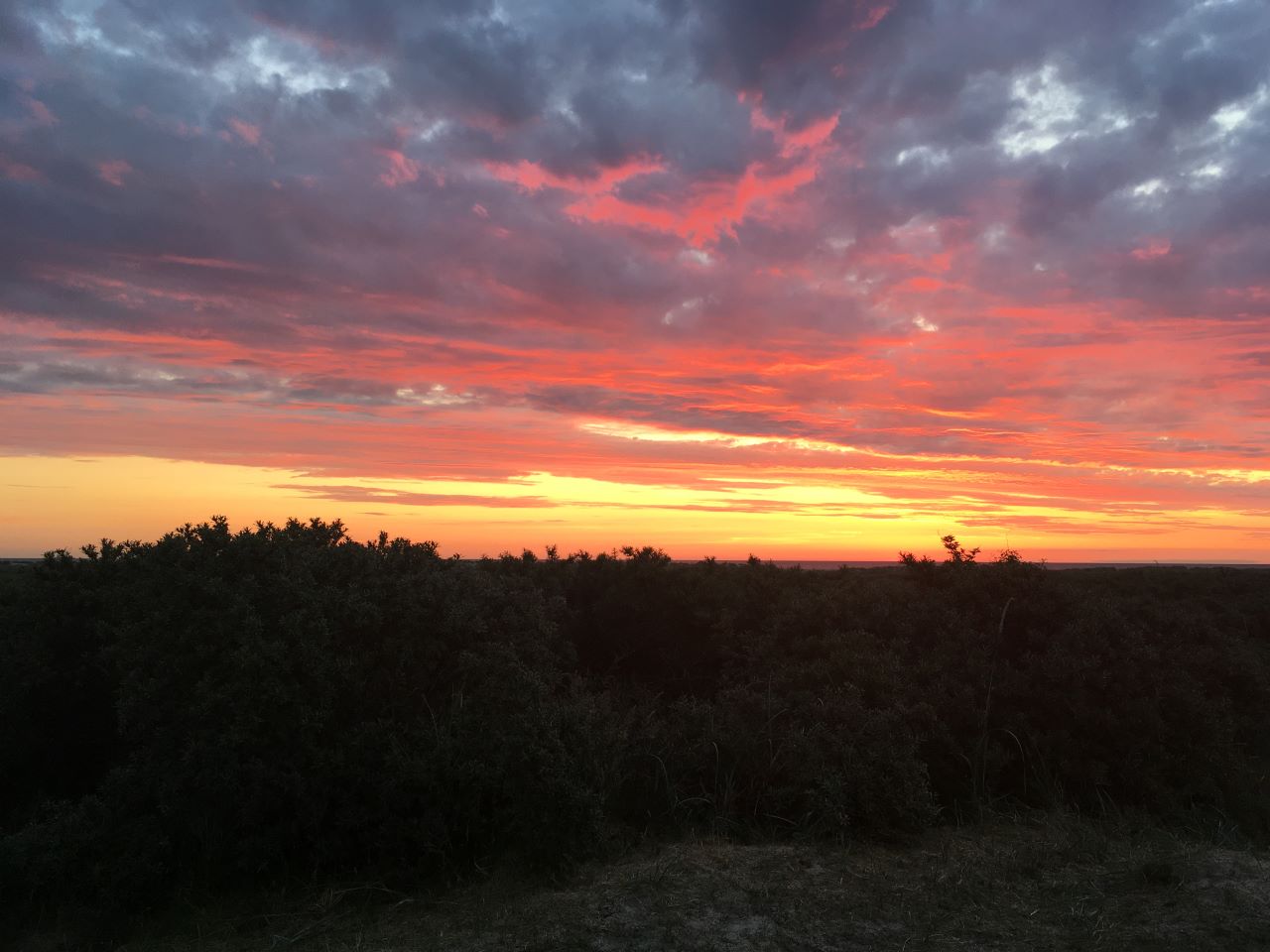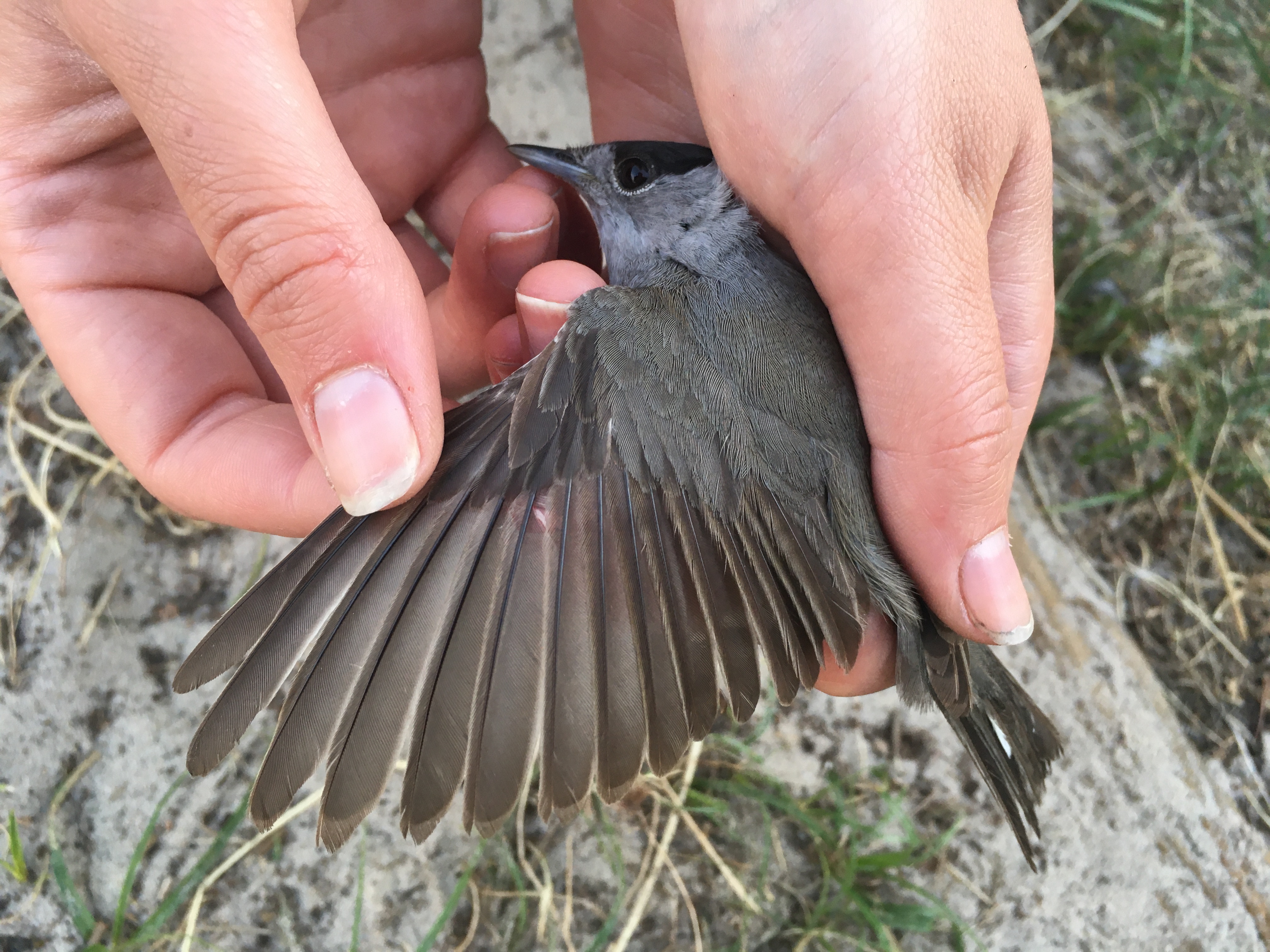Her på Skagen Fuglestations blog bringes korte nyheder i dagbogsformat om hændelser på fuglestationen.
Se indlæg fra måned: jan. (1)feb. (9)mar. (30)apr. (28)maj (31)juni (29)juli (31)aug. (31)sept. (29)okt. (31)nov. (30)dec. (2)
More and more juveniles birds !
This morning, Martina and me went out ringing at Kabeltromlen. The weather was very nice, warm and sunny, as it should be in summer ! We were unsure about how good the day will be for catching birds but we ended up having some nice species in the nets. We caught a female Bullfinch (Dompap Lille) as well as one juvenile and one adult male Reed Bunting (Rørspurv).
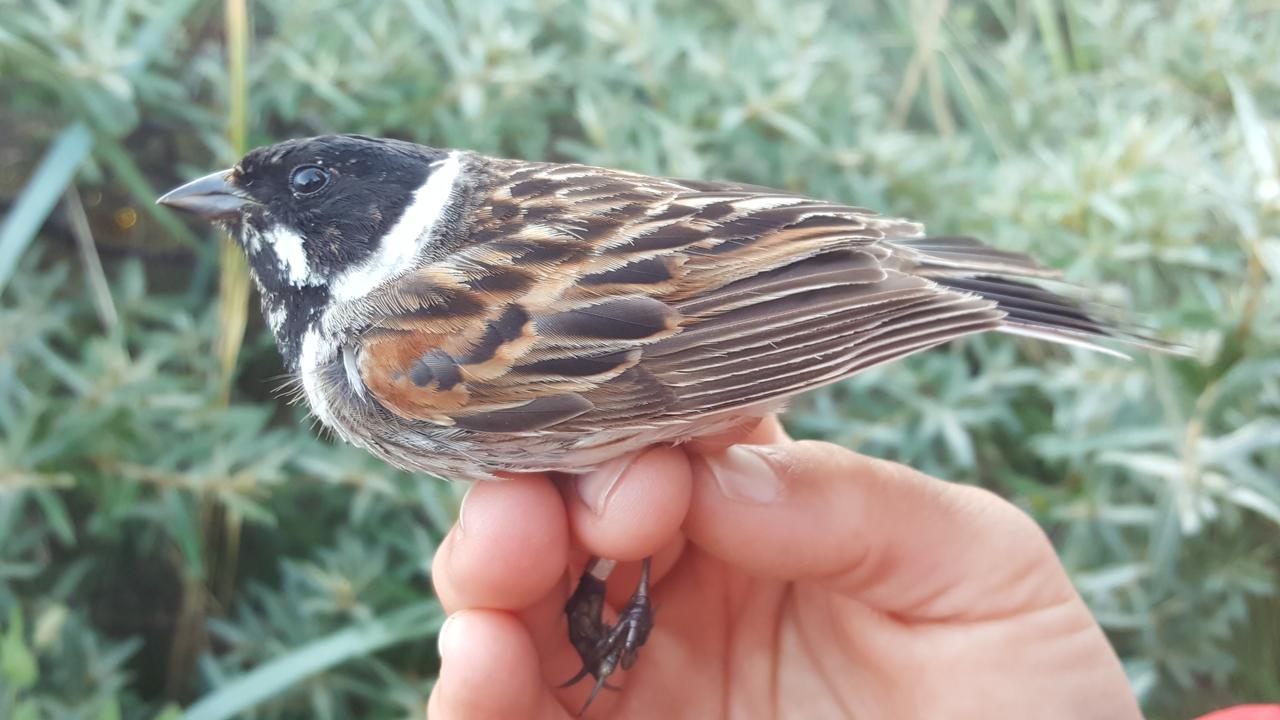 A nice male Reed Bunting (Rørspurv)
A nice male Reed Bunting (Rørspurv)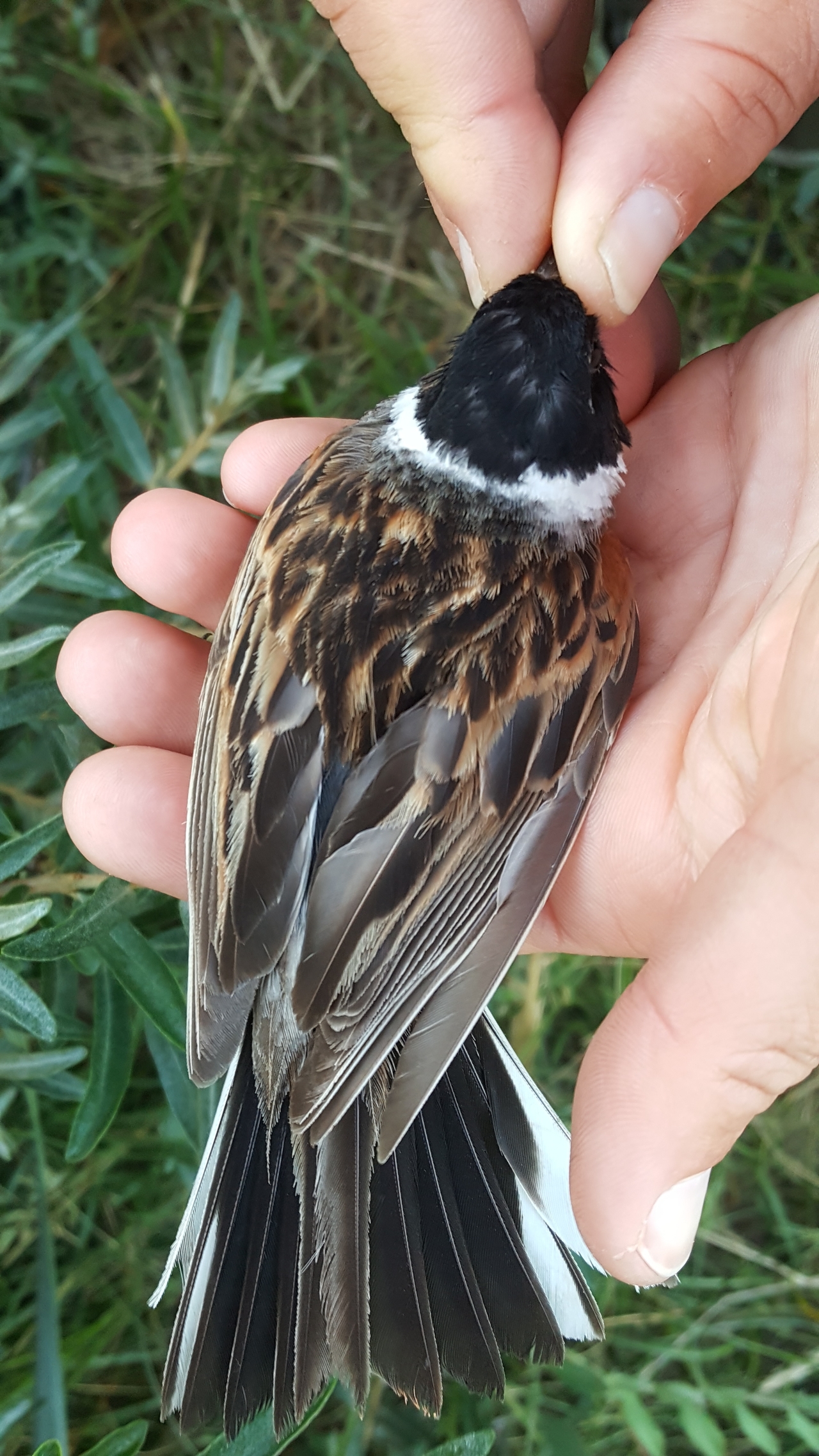
And on our last round, we were lucky and caught a juvenile Grey Wagtail (Bjergvipstjert) !
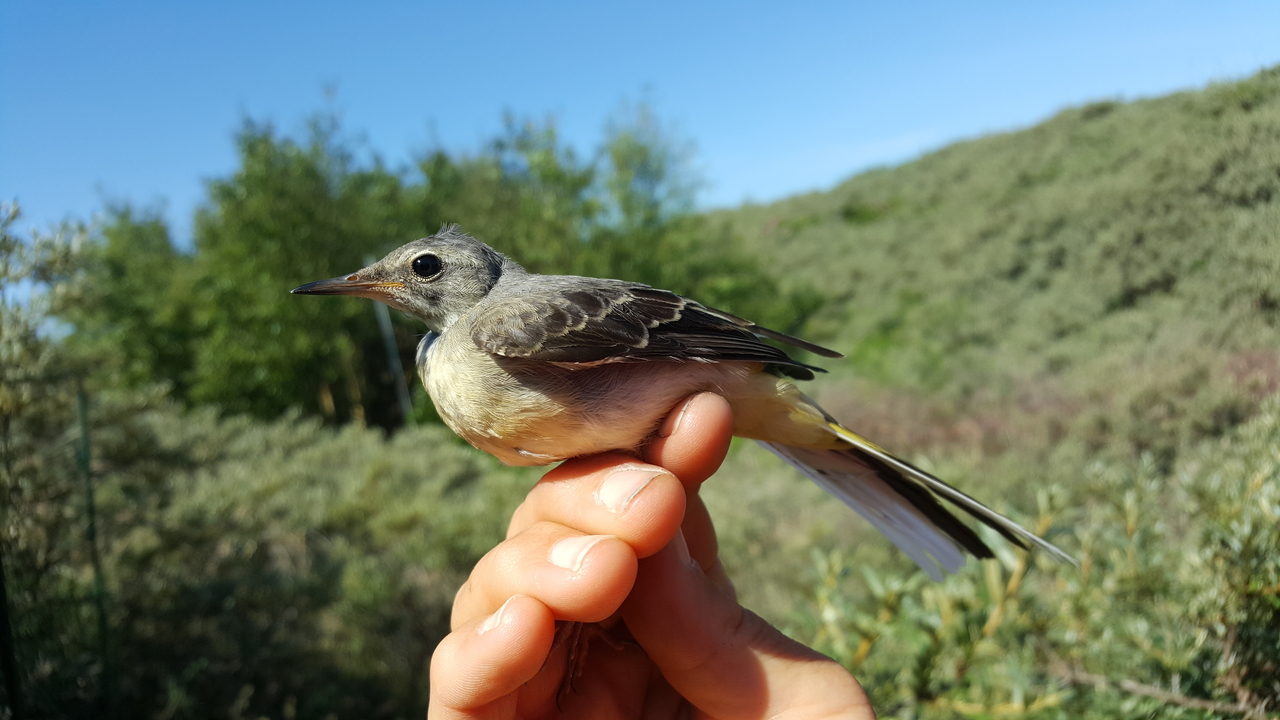
Grey Wagtail (Bjergvipstjert)
We also got juveniles Common Whitethroat (Tornsanger), Great tit (Musvit), Crested tit (Topmejse). Soon we should see some Blackcaps’ (Munk) hatchlings in the nets !
While Martina and I were doing the net checks, Simon and Frederik showed to Pernille’s class how the ringing works via the phone. Frederik ringed a Chiffchaff (Gransanger) in front of the pupils which seemed to be very interested !
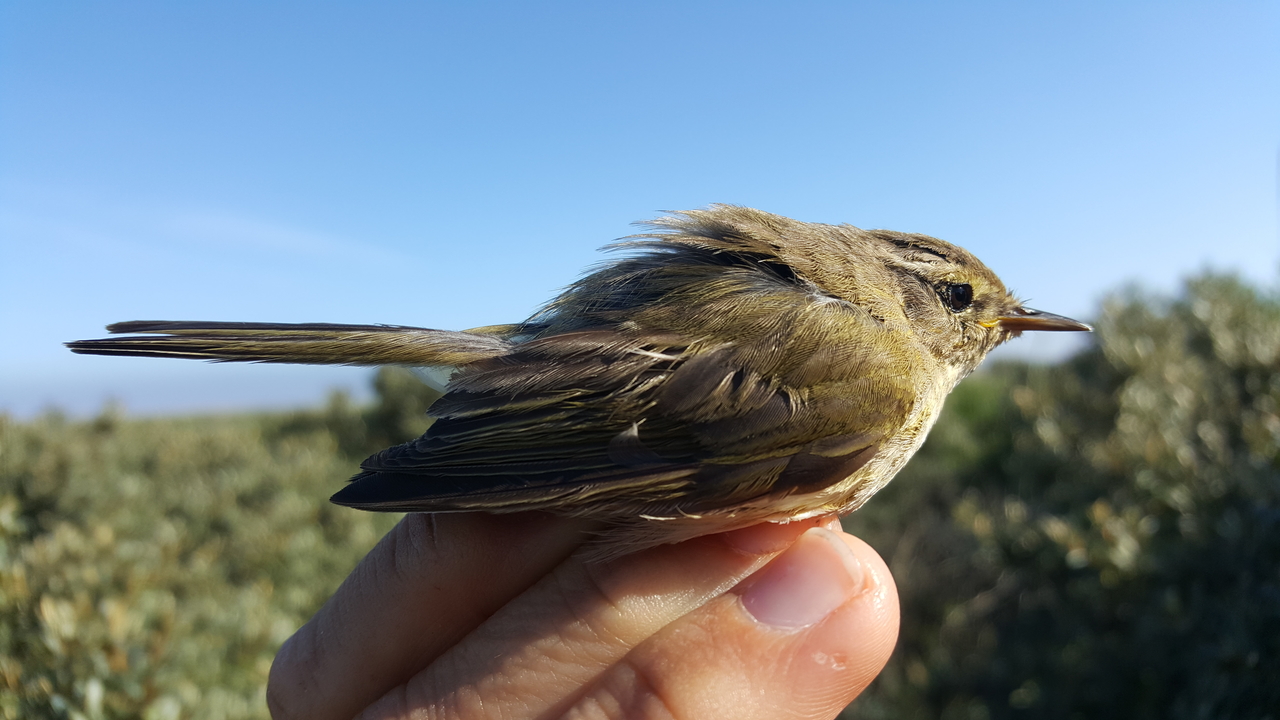 Chiffchaff (Gransanger)
Chiffchaff (Gransanger)
In the afternoon, we set up a trap for moth that we will try overnight. We’re looking forward to see what we catch there tomorrow.
This evening, we are going out trying to catch nightjars with Lars Bo. This should be an exciting night outdoors ! More on this tomorrow in the blog!
Ringmærkning (Kabeltromlen):
Great tit – Musvit – 1
Lesser whitethroat – Gærdesanger – 10
Wren – Gærdesmutte – 1
Marsh warbler – Kærsanger – 2
Reed warbler – Rørsanger – 3
Crested tit – Topmejse – 2
Grey wagtail – Bjergvipstjert – 1
Common whitethroat – Tornsanger – 4
Blackap – Munk – 6
Bullfinch - Dompap, Lille (europaea) – 1
Reed bunting - Rørspurv – 2
Chiffchaff – Gransanger – 4
Total: 38
People : Martina Hillbrand, Amandine Doré, Simon S. Christiansen, Frederik R. Johansen, Pernille Roed
Klik her for at se dagens observationer indtastet i Dofbasen af observatører i området
Klik her for at se opsummeret observationer af rovfugle i Skagen
En Blæsende Dag
I dag blæste det for meget til ringmærkning ved Kabeltromlen, så i dag sov vi længe, og fokuserede på en masse praktisk arbejde.
Men inden vi kommer til det, så vil jeg lige starte med i går aftes. For i går aftes tog vi ned til en gård syd for Skagen, for at ringmærke Slørugler!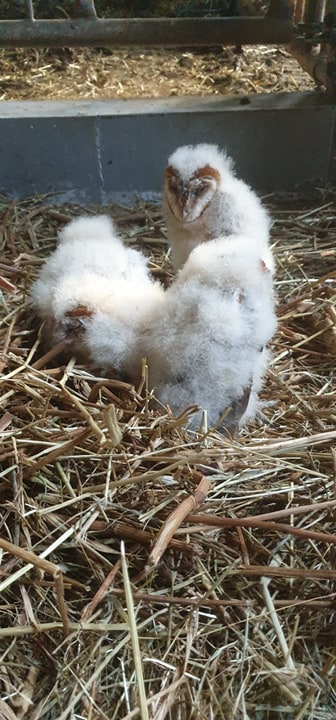
Vi var så heldige og ringmærke hele 5 Slørugle unger! Det var fedt, vi fik også en fed og spændende rundtur rundt omkring ude på engene.
I morges tog jeg ud til Skarvkolonien. Det så godt ud for ungerne, de var blevet store og sunde.
Simon var så heldig at se Steppeørn lige over huset. Det er cool!
Klik her for at se dagens observationer indtastet i Dofbasen af observatører i området
Klik her for at se opsummeret observationer af rovfugle i Skagen
Folk: Simon S. Christiansen, Amandine Doré, Martina Hillbrand og Frederik R. Johansen
Rain
The last of the rain fronts passed through Skagen this morning. We were not sure originally if there would be time to open the nets between sunrise and the rain. Also we had no idea if there would be migrating birds trapped between the fronts or not. By now, I have gotten used to check the rain radar as the first thing I do after my alarm goes off. It promised at least two dry hours to catch birds so we went to open the nets at the usual time (3:15). By the way, as of today the days get shorter and sun rises later which means that we can sleep longer. For now, around 40 seconds per day…
We did catch birds, however, mainly local breeding birds, many of which already had a ring too. Catching ringed birds is always nice because that way you can see that the bird is still in the area, still alive, and we can follow the development of the brood patch when it is incubating eggs and then the moult (like in the willow warbler/løvsanger below).
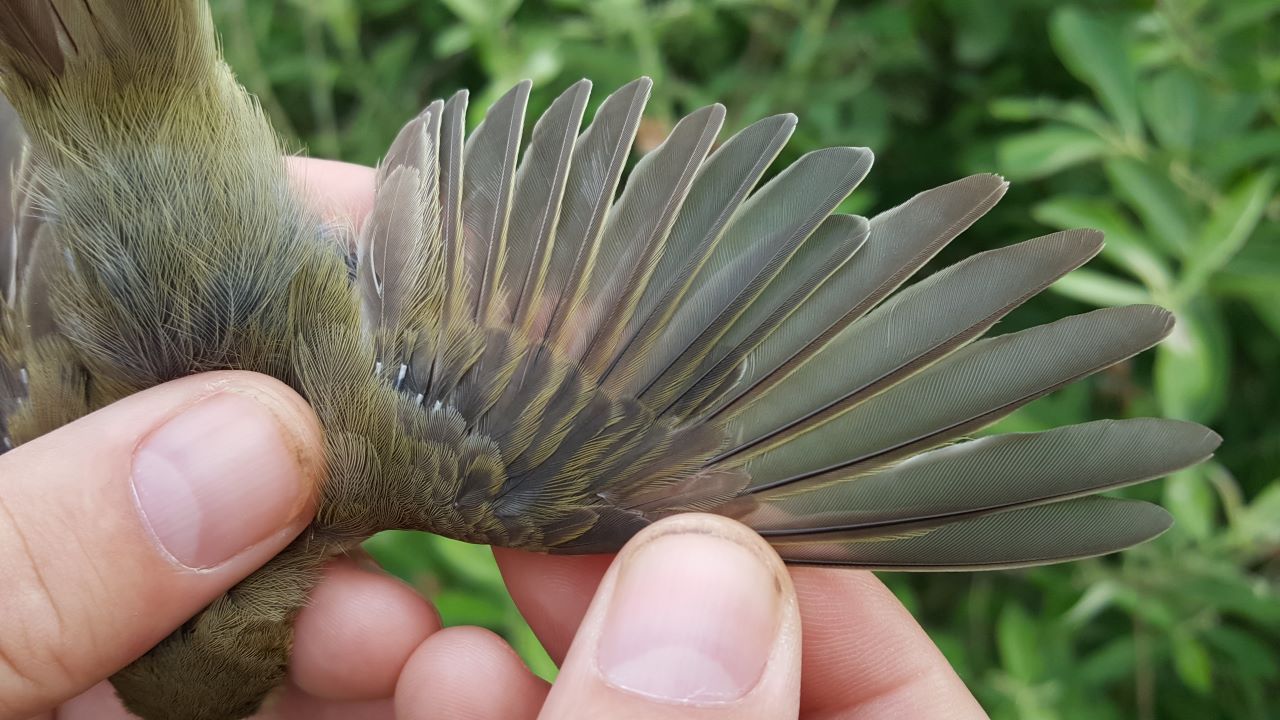
If you catch a bird that you ringed in a different year, of course, it is still more interesting as then you can also study things like site fidelity and survival. Even though we again caught many blackcaps (munk) we haver very few recaptures of those. The recaptures are mainly lesser whitethroat (gærdesanger) and common whitethroat (tornsanger). This might suggest that the blackcaps are not spending a lot of time in this area but only move through probably foraging. This would also explain why we catch so large numbers of blackbirds which is definitely more than the number of territories the small area where we have set up nets can provide.
We had two very interesting birds in the net today as well: redwings (vindrossel). They are regularly caught here on migration in early spring and later in the fall, however, at this time of the year it is unusual to catch them here as they do not breed in the close surroundings. It is even more surprising then that we caught not only one but two of these. Maybe they do breed in the near surroundings after all? Or they lost their nest and decided to give up on the breeding for this year and explore the north of Denmark some more.
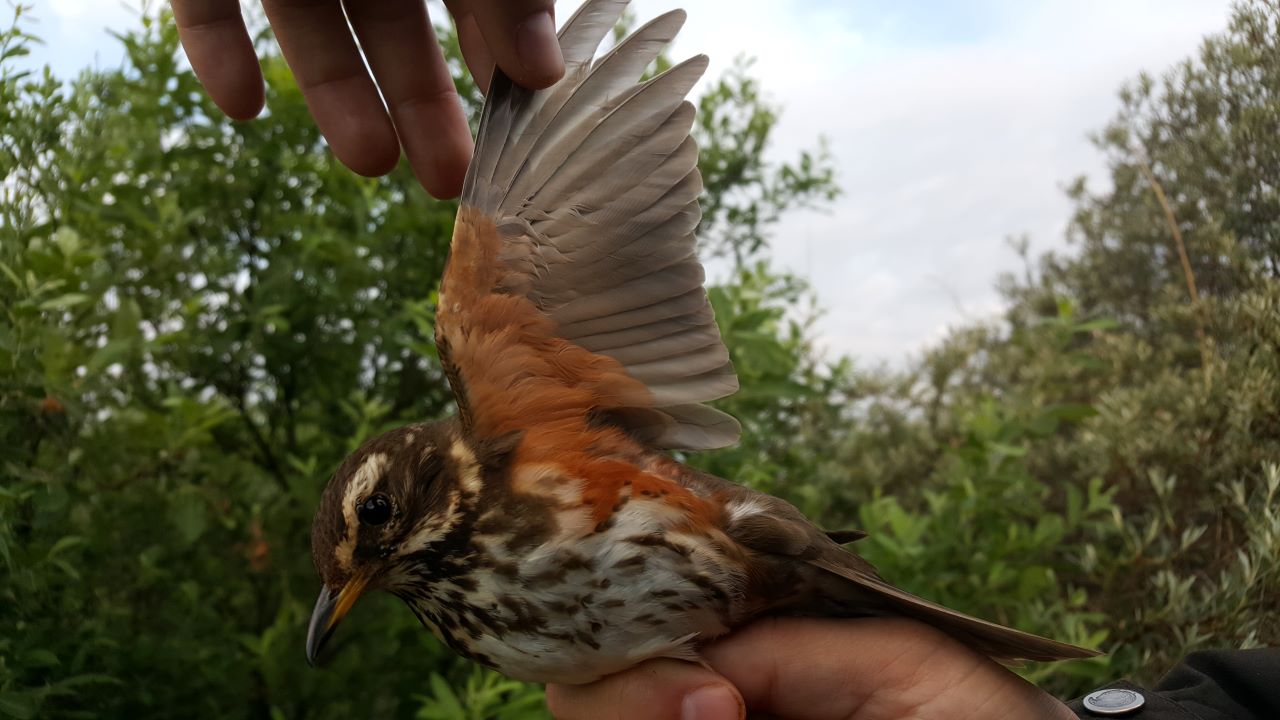
A little later than predicted the rain came and we had to close the nets much earlier than we normally would. This meant we had the chance to catch up on some sleep which was very welcome. Well rested and with sunshine after the rain we went out in the afternoon to the north beach to see if maybe the weather has brought us any rare birds. We could not find rare birds, however, we found another nest of a ringed plover and we saw several more plovers without chicks which are probably still incubating as well. Therefore we still have to advise visitors to the beach to be careful and watch your step. As you can tell, the eggs are really hard to spot!
Also on the beach are large numbers of gulls (lesser black-backed (sildemåge), greater black-backed (svartbag), and herring gull (sølvmåge)) and some sandwich terns (splitterne).
In the evening we have been invited by Lars Bo to help him with the ringing of barn owl chicks. Since we expect to get home late we will share the pictures in tomorrow’s blog. Also in the evening Frederik came back, so now we are back in full strength and ready for lots more birds. Raptor migration should pick up again from tomorrow noon when the wind slows down.
Ringmærkning (Kabeltromlen):
Havesanger – Garden Warbler - 1
Munk – Blackcap – 8
Løvsanger – Willow Warbler – 1
Gærdesanger – Lesser Whitethroat – 2
Bogfinke – Chaffinch - 1
Vindrossel - Redwing - 2
Total: 15
People : Martina Hillbrand, Simon S. Christiansen, and Amandine Doré
Klik her for at se dagens observationer indtastet i Dofbasen af observatører i området
Klik her for at se opsummeret observationer af rovfugle i Skagen
After the storm – migration continues
We learned in the last few days that the weather forecast should not always be trusted so despite the bad forecast I woke up early this morning to check if it was still raining and what the rain radar said. It was not raining and according to the rain radar the rain, after all, had passed much faster than initially expected and we could go out ringing at the normal time. So we got up and went to Kabeltromeln as usual. We opened the nets but knew that after a rainy night probably not a lot of birds would be in the nets.
To our surprise actually it seems like warbler migration might have picked up a little again, despite the weather. More birds are expected next week with continuous southerly winds. This should also let raptor migration pick up again. We caught both reed warblers (rørsanger) and marsh warblers (kærsanger) today, which is nice because they are very difficult to distinguish unless you hear them singing. Seeing them next to each other always helps a lot in distinguishing two species.
We also caught the by now mandatory blackcaps again, but not as many as the last few days. However, we caught a really interesting one, which, once again, proves what I said here earlier: catching lots of birds of one species can give you some very interesting insights in many topics.
We caught a female blackcap that was showing a streak of black in its cap – probably male colouration. It is not often seen in the wild, but also it is only obvious in birds with strong sexual dimorphism, but birds with both male and female plumage have been reported before and studies on captive birds show that birds can actually completely reverse their sex and female birds can even develop male gonads (Riddle, 1924, Proceedings of the American Philosophical Society). It would be really interesting if this bird is on its way to change its sex or if it just has a little genetic “defect” that causes this colouration (note: the black was only on one side of the head, the other side looked normal female).
Next to the “usual suspects” we also had a couple blue tits (blåmejse) recently fledged. Both of them flew very well, although you could tell from the flight the lack of experience. It is always amazing, though, to think how quickly young birds learn to fly. After all, it requires a very good coordination – especially the landing.
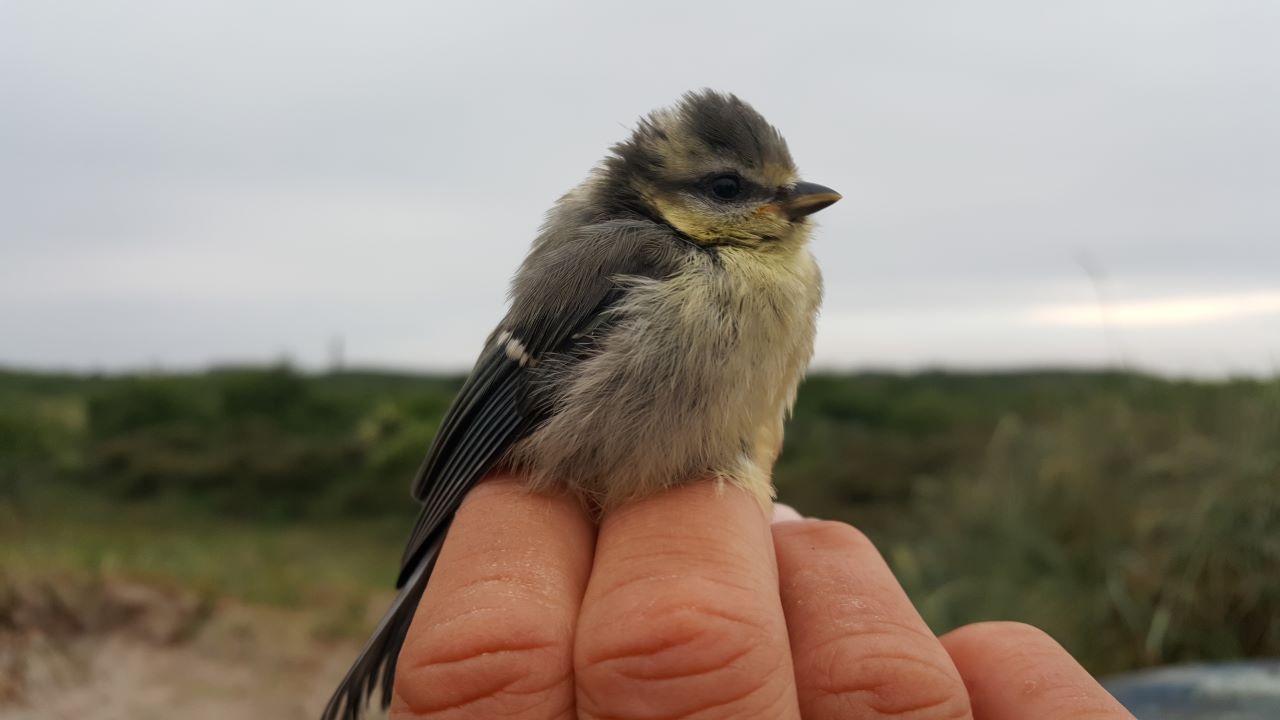
A nice surprise was the pied flycatcher (broget fluesnapper) which we normally only get during migration a lot earlier or much later in the year. This one was probably a male that either decided that it doesn’t want to breed this year and still enjoy its youth a little bit more, or it has arrived at the breeding grounds but didn’t find a partner (since females tend to choose males with stronger coloration, which, in this species, comes with older age) and then decided to start its way back to the wintering grounds earlier. Or it was just lost on the northward migration and is now just really, really late – which means that probably anyway he won’t breed this year. Of course, flycatchers are among our favorite birds here, since they eat mosquitos, which we are very happy to sacrifice to the birds.
We did not catch many birds and after six hours we wanted to close the nets as usual. On the closing round, we found a very big surprise in the net: a green sandpiper (svaleklire). Shorebirds have a very long and generally very early migration season. It is also well know that the spring and fall migration of shorebird overlap – so while some of them still migrate to their breeding grounds, others are already on their way south. This bird was probably already on its way south. Green sandpipers winter in the Mediterranean and in subtropical and tropical Africa.
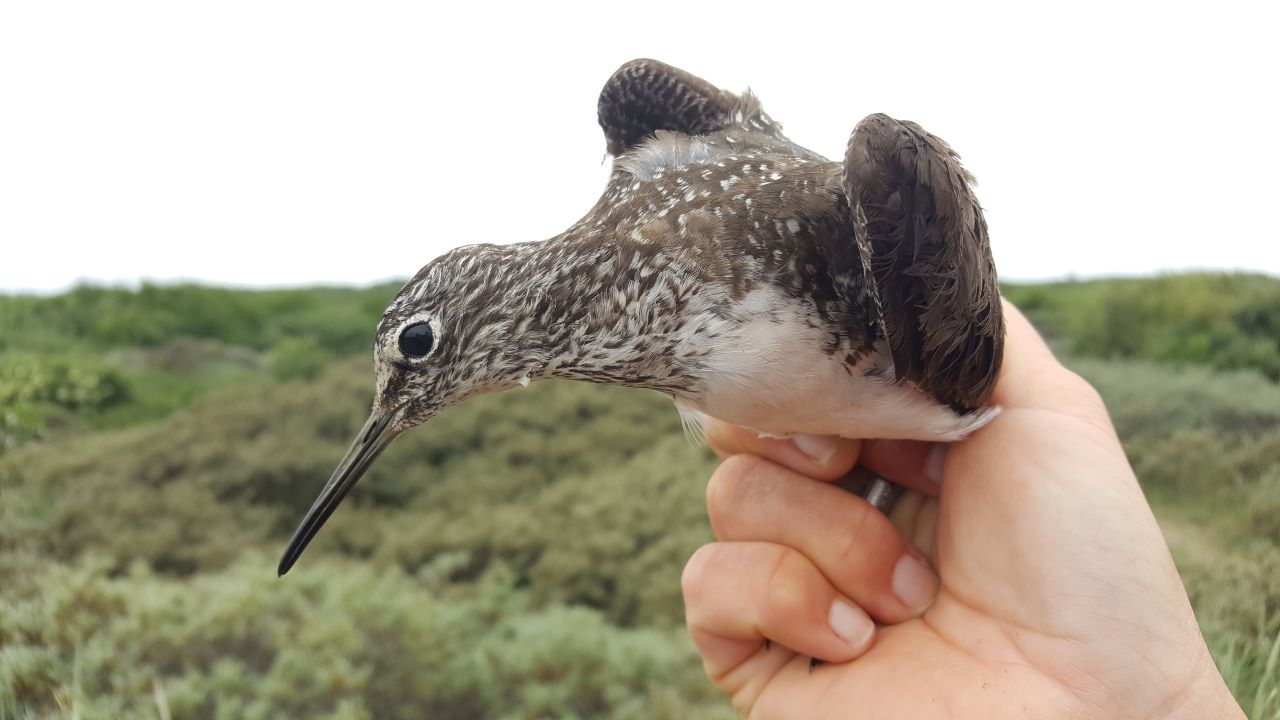
In the afternoon we welcomed the new guests for the apartment and we had a meeting with Simon since he had not been here the whole week.
Ringmærkning (Kabeltromlen):
Havesanger – Garden Warbler - 1
Tornsanger – Common Whitethroat – 1
Munk – Blackcap – 7
Kærsanger – Marsh Warbler – 7
Rørsanger – Reed Warbler – 6
Blåmejse – Blue Tit – 2
Broget Fluesnapper – Pied Flycatcher – 1
Løvsanger – Willow Warbler – 1
Svaleklire – Green Sandpiper - 1
Total: 27
People : Martina Hillbrand, Simon S. Christiansen, and Amandine Doré
Klik her for at se dagens observationer indtastet i Dofbasen af observatører i området
Klik her for at se opsummeret observationer af rovfugle i Skagen
A slow catching day
Today was a quiet ringing day at Kabeltromlen. The sky remained cloudy the whole morning, but luckily it did not rain and we were able to keep the nets open. It was a slow day and we caught few birds. And all the Backcaps (Munk) were apparently gone ! We instead caught several Garden Warblers (Havesanger).
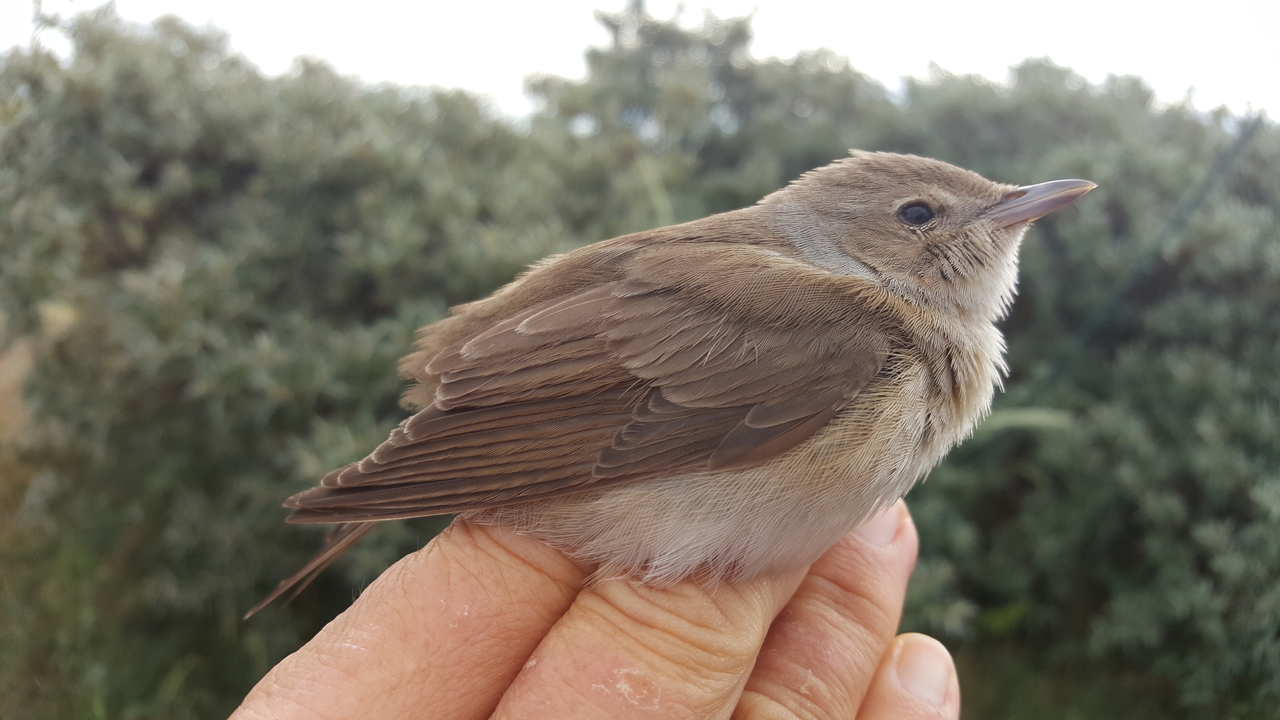
Garden Warbler (Havesanger)
One highlight of the morning was a very bright red male Bullfinch (Dompap Lille). Contrary to other pigments, red pigments are not directly produced by the birds. Instead, red birds rely on carotenoids - molecules found in the food they eat – to acquire a red coloration. Food such as leaves, seeds, berries and fruits are rich in carotenoids. However, carotenoids are a yellow pigment, and birds therefore need to use enzymes to convert them into red pigments. Brightness and extent of the red pattern is therefore affected by diet in red birds. A study1 from 2001 have compared coloration of wild and captive bullfinches and found that this bird has a unique way of producing red pigments, different from other close related species, which is quite interesting !
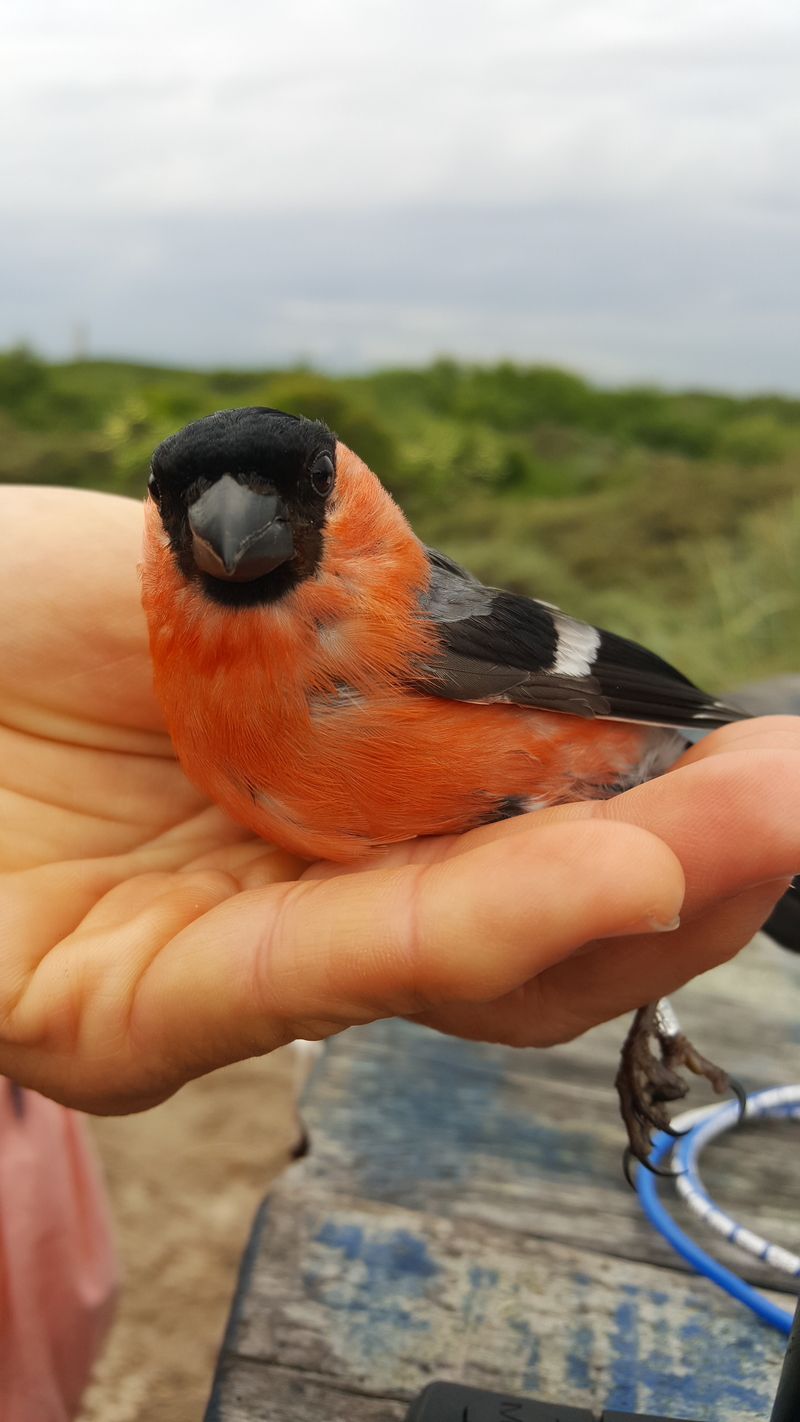
Bullfinch (Dompap Lille)
1 Stradi R, Pini E, Celentano G. Carotenoids in bird plumage: the complement of red pigments in the plumage of wild and captive bullfinch (Pyrrhula pyrrhula). Comp Biochem Physiol B Biochem Mol Biol. 2001;128(3):529-535. doi:10.1016/s1096-4959(00)00353-5
Ringmærkning (Kabeltromlen):
Rødstjert – Common Redstart – 1
Rørsanger – Reed Warbler – 2
Gærdesanger – Lesser Whitehtroat – 1
Lille Gråsisken – Lesser Redpoll – 2
Kærsanger – Marsh Warbler – 1
Løvsanger – Willow warbler – 2
Munk – Blackcap – 4
Havesanger – Garden Warbler – 5
Tornsanger – Common Whitethroat – 2
Dompap lille – Bullfinch – 1
Total: 21
People : Martina Hillbrand and Amandine Doré
Klik her for at se dagens observationer indtastet i Dofbasen af observatører i området
Klik her for at se opsummeret observationer af rovfugle i Skagen
Where did all the blackcaps come from?
This morning we went ringing without big expectations because the weather, although nice, did not promise a lot of birds with north winds and scattered rain clouds. It was good for a beautiful sunrise, though. The payment for getting up at 2.30 in the morning…
We are only two people now so not having too many birds is fine. We got a big surprise, however, when we started checking the nets and they were full of blackcaps (munk) in several net checks. Of course, we know that blackcaps are breeding around our nets and we can hear them singing and we also expect the young birds to fledge soon so there will be more. But today we ringed 30 (!) adult blackcaps almost all of which had a brood patch, meaning that they are actively breeding here or in the near surroundings. Also, very few of them were recaptures and seeing that we already had quite a few blackcaps yesterday we simply don’t know how they suddenly all ended up in our nets. The best guess is that the Corona restrictions for blackcaps have been lifted and they are finally allowed to have parties again.
The nice thing about catching a lot of birds of the same species is that you get really good in aging them and you can see even small differences in wear. You can look for the moult limit in the alula and the rather heavy wear of the flight feathers in this second year male:
Also getting a lot of data from birds of one species helps to do population studies and the like. So we definitely don’t complain about having lots of blackcaps. After all, they are very nice birds with a very beautiful song!
Next to lots of blackcaps we also caught a very pretty adult male redpoll (lille gråsisken).
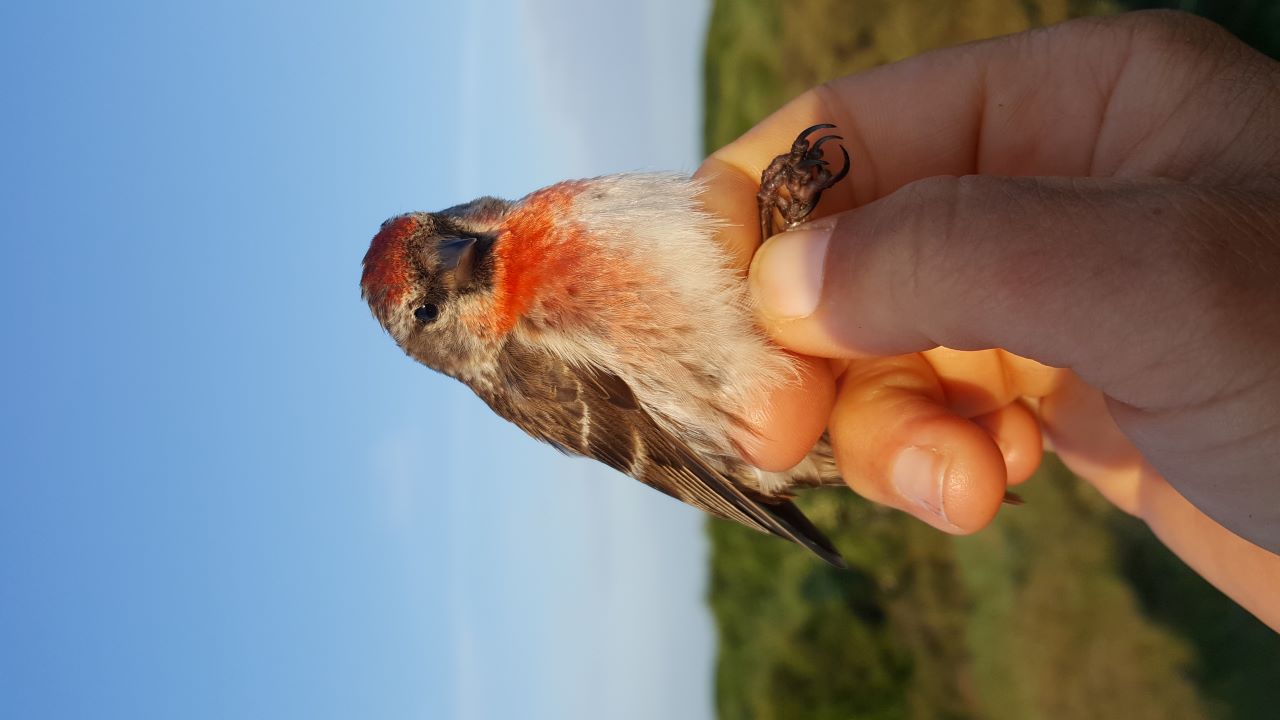
A nice surprise was a rosefinch (karmindompap). A male had been singing close to the ringing site many days but not continuously so we had no idea that it actually had a territory there but today we caught a female with an active brood patch. This is nice because in the last few years this bird was not known to breed around Skagen.
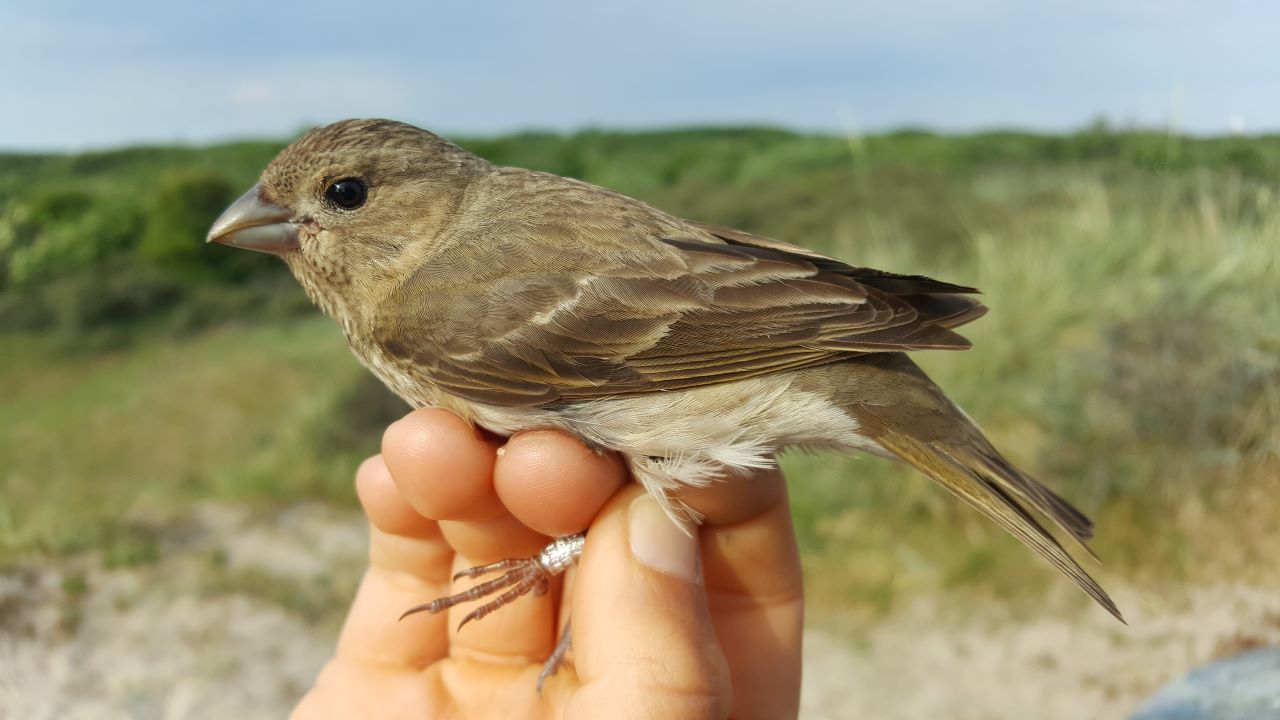
In the afternoon we went to the cormorant lake to monitor the breeding success there. Many chicks are by now so big you can also easily see them with binoculars. However, their feathers are still very thin and cannot get wet, so the parents still have to provide food and also protection from both sun and rain for the little ones. But it is good to see that they are growing fast and it looks like almost all nests have chicks by now.
Ringmærkning (Kabeltromlen):
Gransanger – Chiffchaff - 1
Havesanger – Garden Warbler - 4
Munk – Blackcap – 30
Topmejse – Crested Tit – 9
Rørsanger – Reed Warbler – 1
Gærdesanger – Lesser Whitethroat – 1
Lille Gråsisken – Redpoll – 2
Gærdesmutte – Wren – 1
Karmindompap – Rosefinch – 1
Total: 50
People : Martina Hillbrand and Amandine Doré
Klik her for at se dagens observationer indtastet i Dofbasen af observatører i området
Klik her for at se opsummeret observationer af rovfugle i Skagen
Exciting birds in the nets and in the sky !
Today, we went back ringing at Kabeltromlen, trying out our new nets disposition in the reeds. The weather starts to be very hot, and mosquitoes more and more numerous !
It was a really good day for catching, and we ringed almost 40 birds, of which a large part were female Blackcaps (Munk).
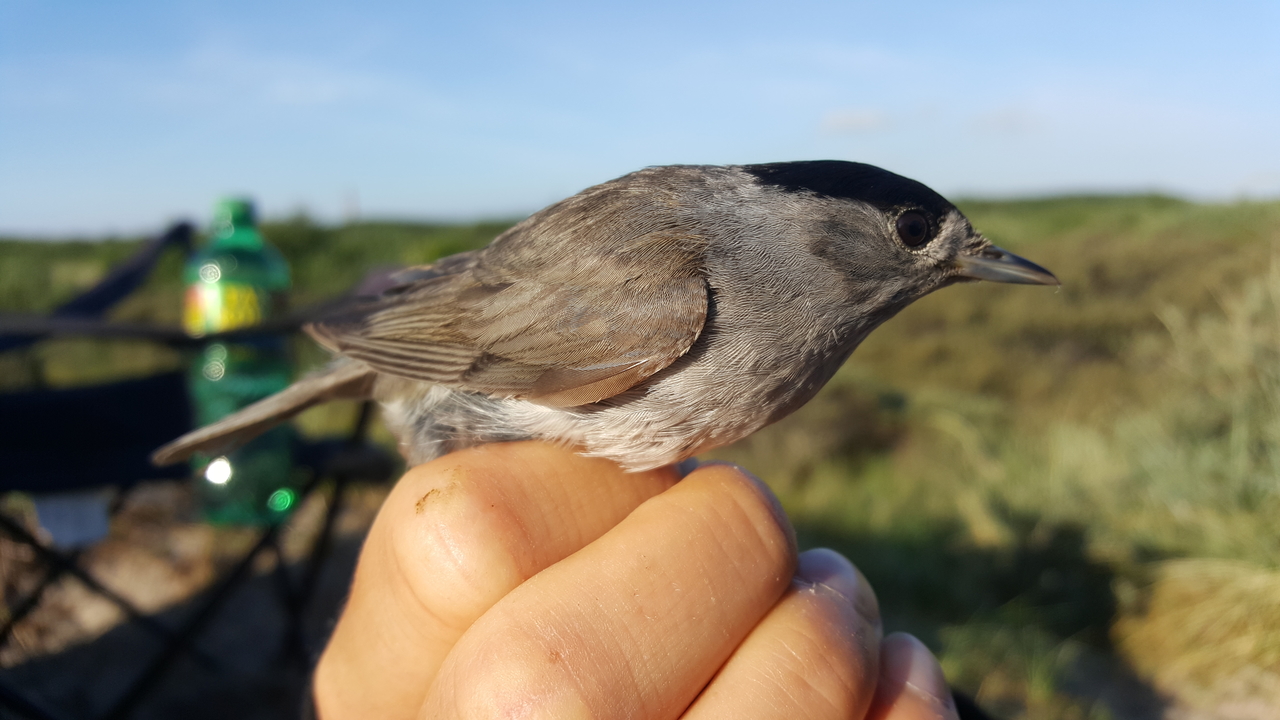
In the first round we also caught a female Grey Wagtail (Bjergvipstjert).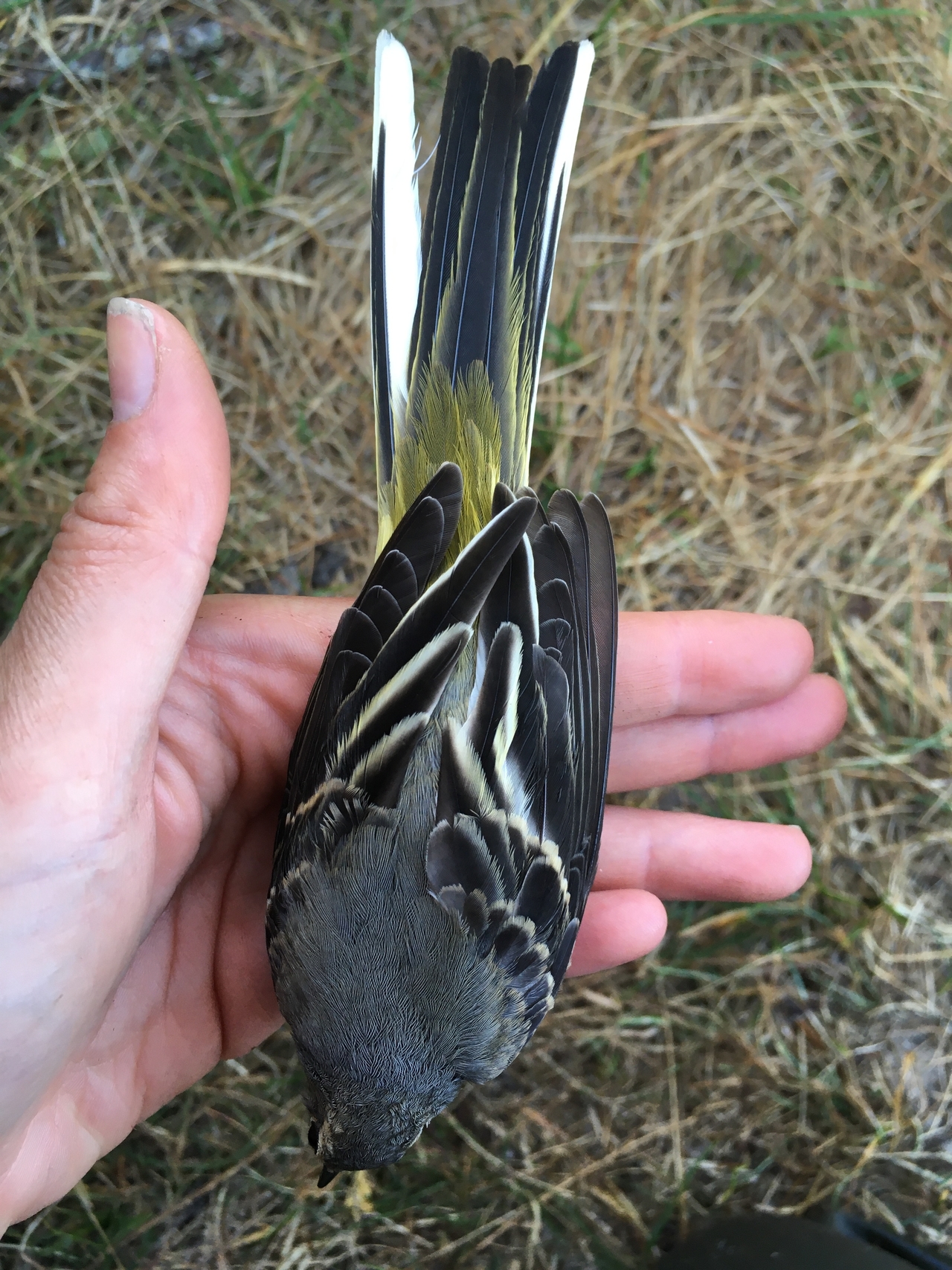
Later on, we were surprised to catch two newly hatched and very pretty Bearded tits in the reeds !
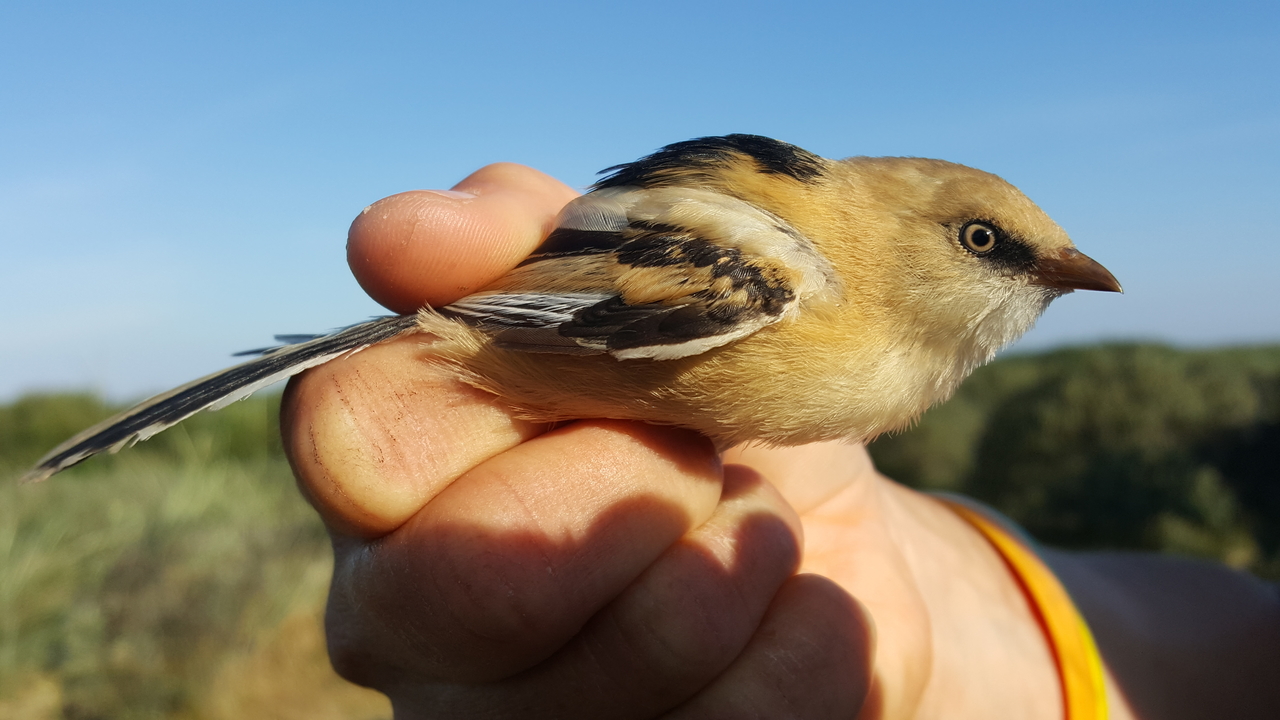
Since several days, we have also been catching Crested tit’s (Topmejse ) hatchlings in the nets, and today we got 3 of them ! There are several characteristics that can be used to differentiate newly-hatched Crested tits from older birds: usually the crest is not fully developed, the eye is brown while in the adults it is reddish-brown, and some parts of the body still don’t have feathers.
We are expecting to catch more and more hatchlings, as the season progresses. We have so far caught young Crested tits, Bearded Tits, and Blackbirds, and more should come soon !
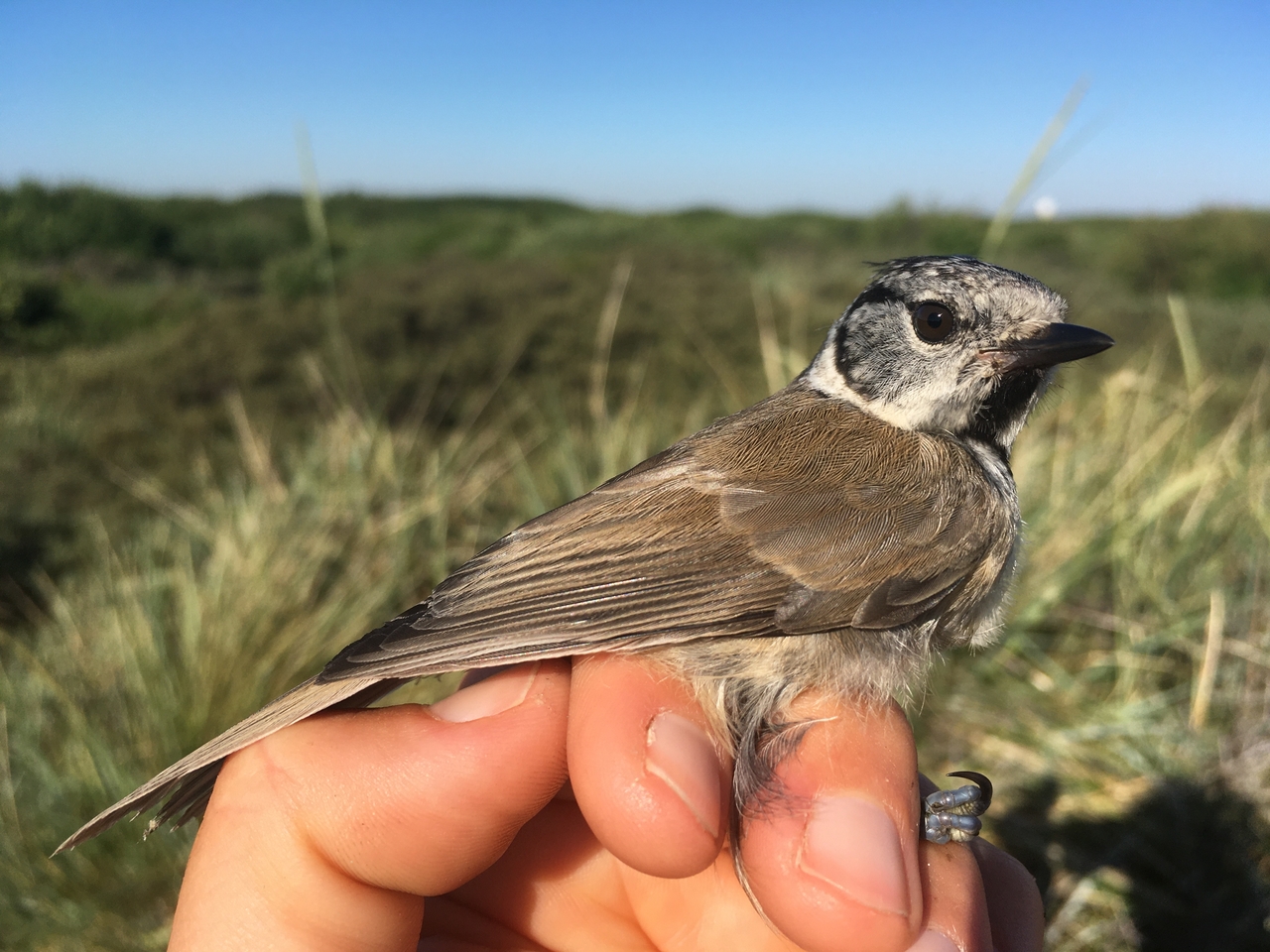
On our last round, we caught one very beautiful Hawfinch male (Kernebider). Hawfinches are unmistakable thanks to their very massive and wide bill that they use to feed on large hard seeds (such as cherry seeds).
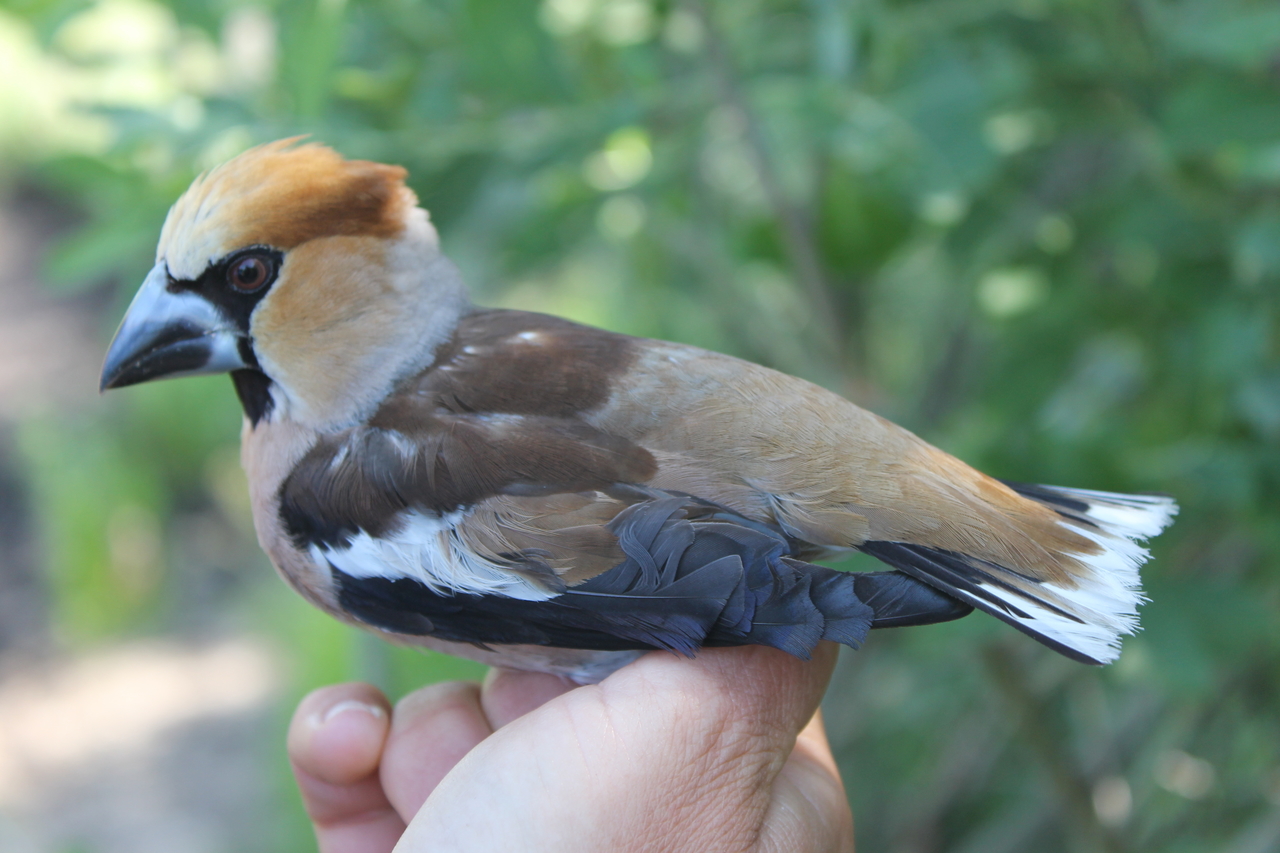
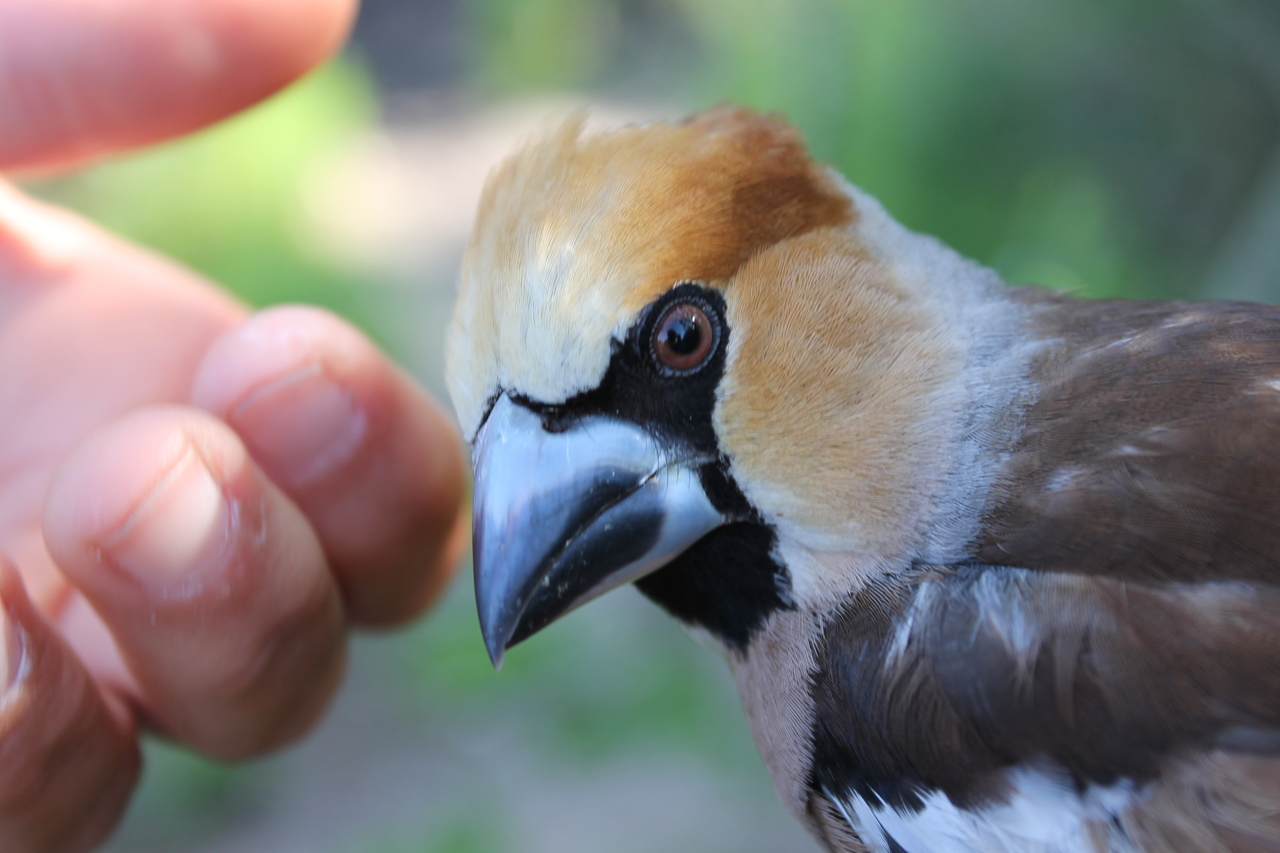
We also caught two Lesser redpolls (Lille Gråsisken).
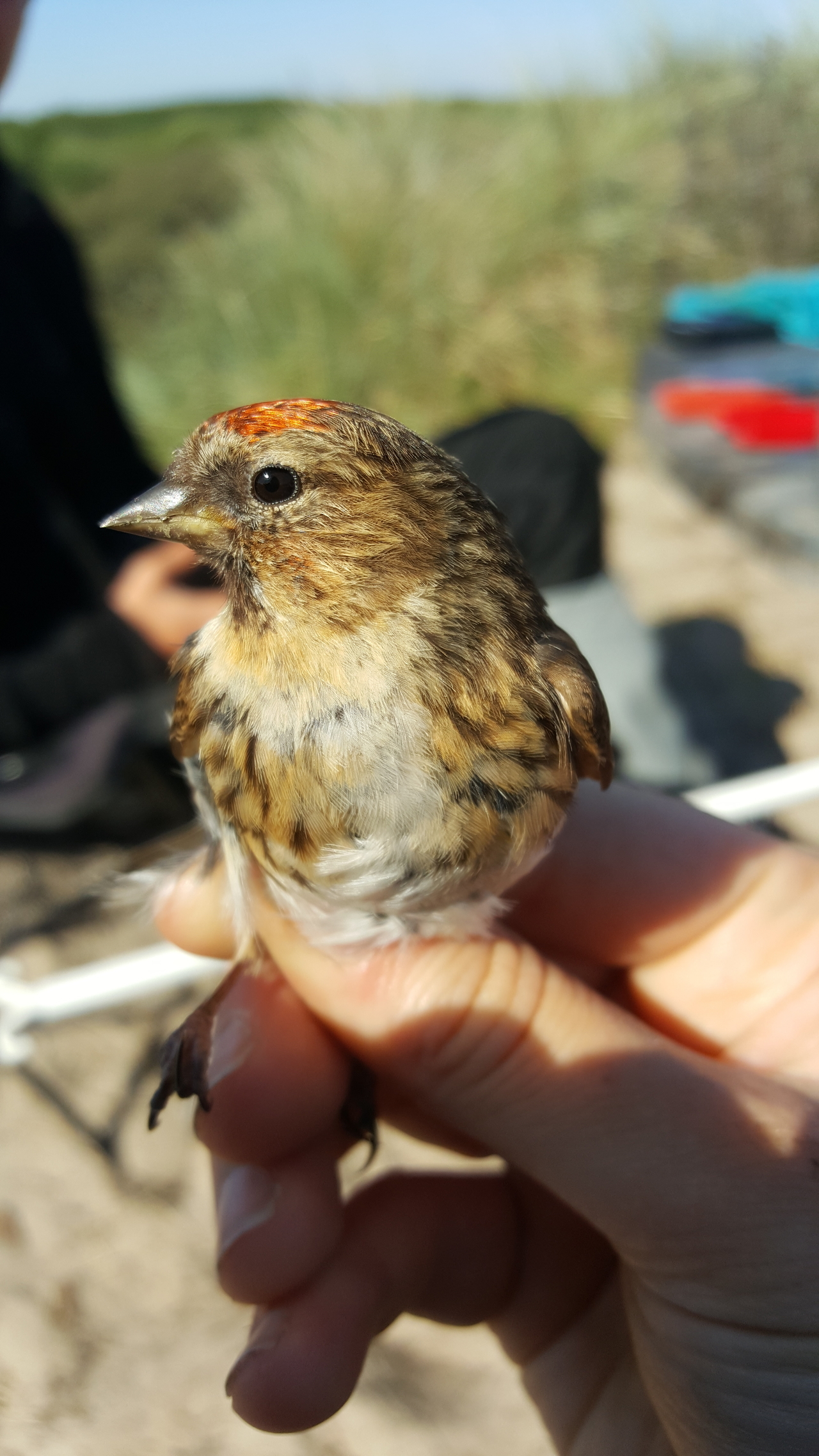
And last but not least, we saw again a Lesser-spotted Eagle (Lille skrigeørn) alongside Common and Honey Buzzards while ringing !
In the afternoon, we followed our normal routine, completing our daily tasks. Frederik left and will come back on Monday.
Ringmærkning (Kabeltromlen):
Gransanger – Chiffchaff - 1
Havesanger – Garden Warbler - 4
Munk – Blackcap – 16
Topmejse – Crested Tit – 3
Kærsanger – Marsh Warbler – 1
Rørsanger – Reed Warbler – 1
Sangdrossel – Song Thrush – 1
Gærdesanger – Lesser Whitehtroat – 2
Solsort – Blackbird – 1
Skægmejse – Bearded Tit – 2
Bjergvipstjert – Grey Wagtail – 1
Kernebider – Hawfinch – 1
Lille Gråsisken – Redpoll – 3
Total: 37
People : Martina Hillbrand, Frederik R. Johansen and Amandine Doré
Klik her for at se dagens observationer indtastet i Dofbasen af observatører i området
Klik her for at se opsummeret observationer af rovfugle i Skagen
Amphibians and Eagles
Today was another day for the CES ringing at Jennes Sø. This focusses on breeding birds so we catch fewer new birds and more recaptures. It gives us a chance to follow some individual birds over a longer period of time. For example we had a blue tit (blåmejse), a pretty male, which has probably already finished breeding and has now started to moult its wing feathers. Males often start to moult earlier than females as females tend to have more work with the offspring (of course we do not want to draw any parallels here to the world of the humans).
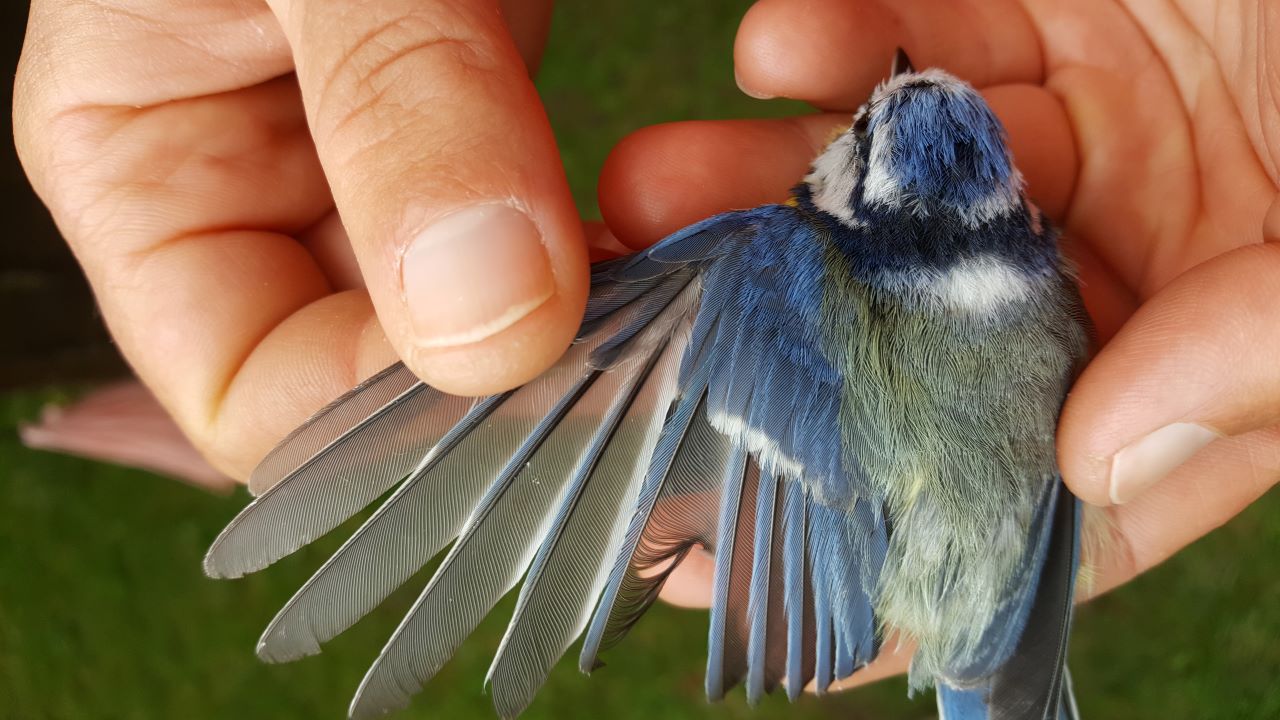
We only ringed 10 birds today but we also had 6 recaptures, and although we had few birds at least we had some variety. And it was not hot as in the morning it was raining a little bit.
We also caught this beautiful tree pipit which was nice since normally we hear them sing all the time but we rarely catch them.
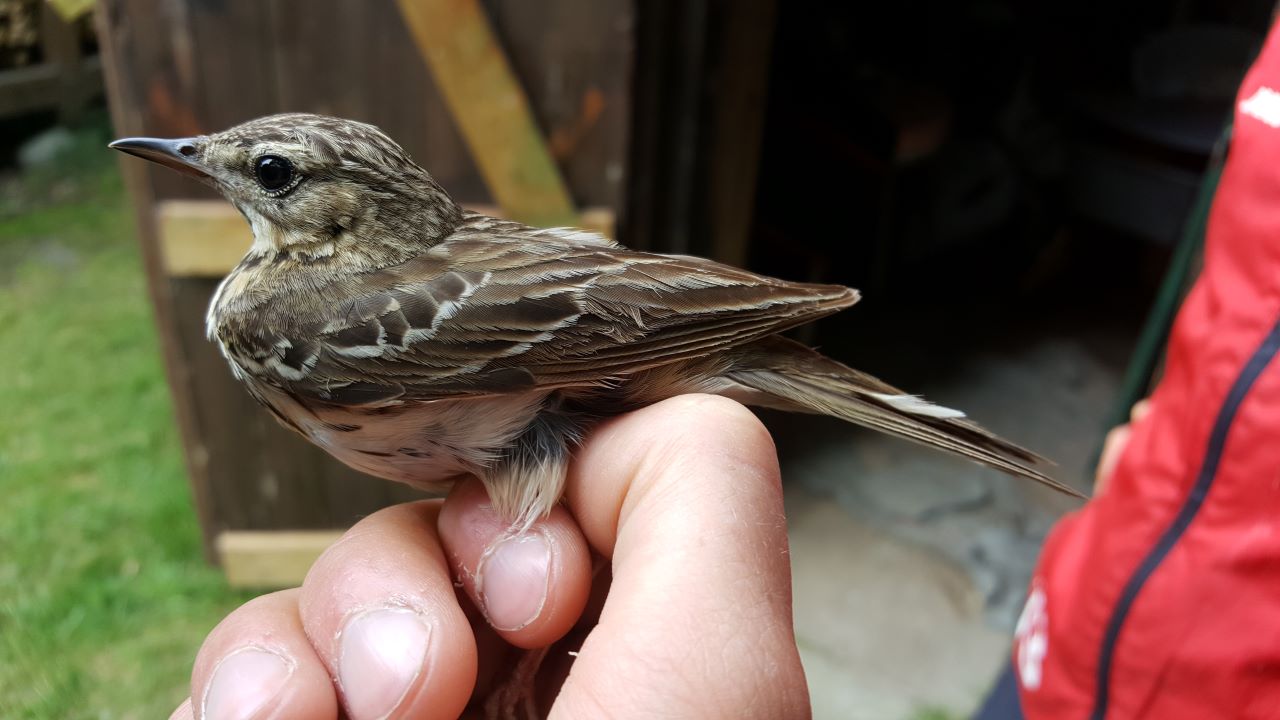
Also, since there were not that many birds, we got to study a few other animals too. The lake was full of tadpoles, some without legs and some already with legs. And on the grass dozens of tiny baby toads were hopping away from the water. A good chance to see the development of amphibians close up.
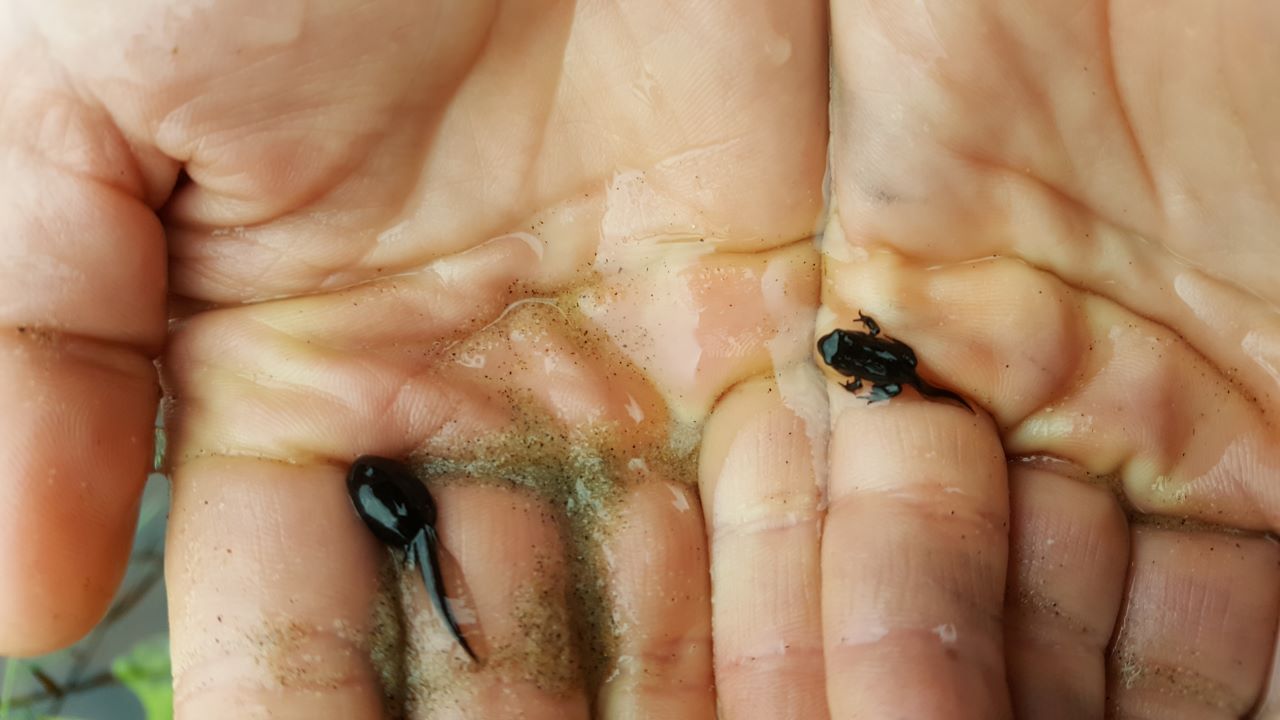
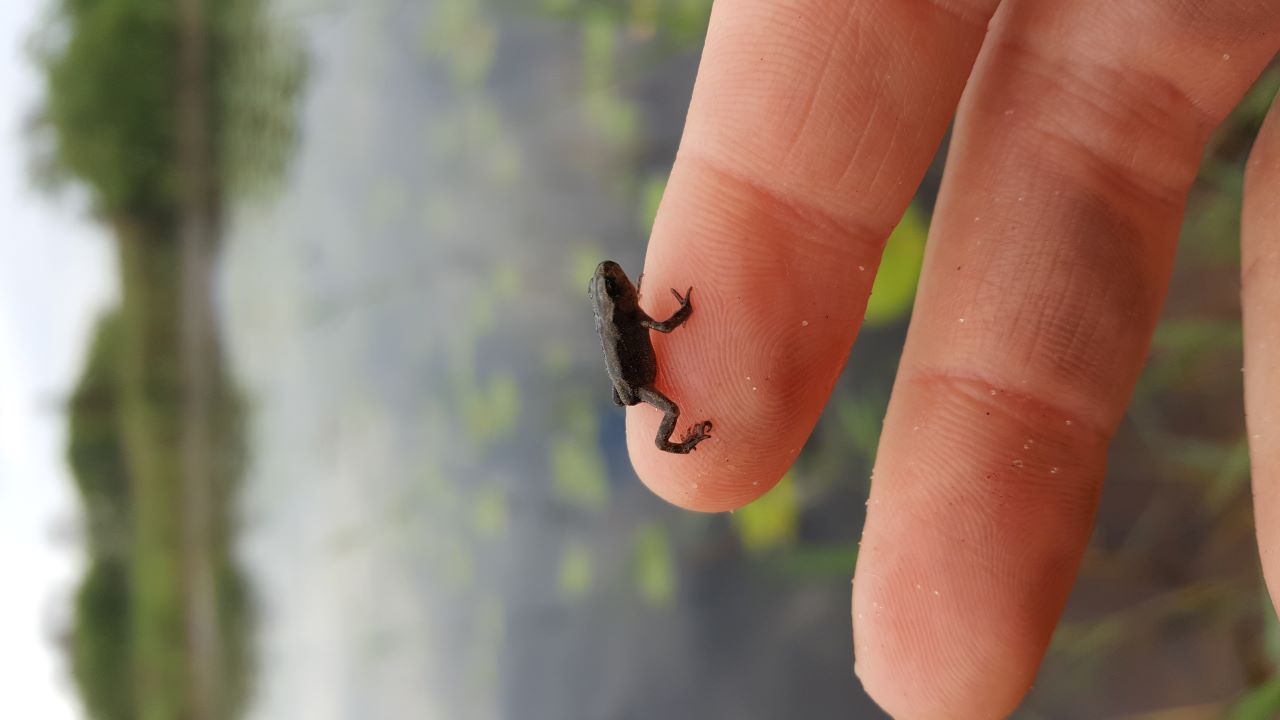
After the ringing we went home and while the girls slept Frederik went out to look for raptors and he was lucky enough to finally see the steppe eagle (steppeørn) he had always missed when it was here. Apparently it is the same bird that was here several days two weeks ago and then left. It was seen in Aalborg yesterday but after a short visit to the rest of Denmark decided to come back here. We can totally relate to that since here is just the best part of Denmark!
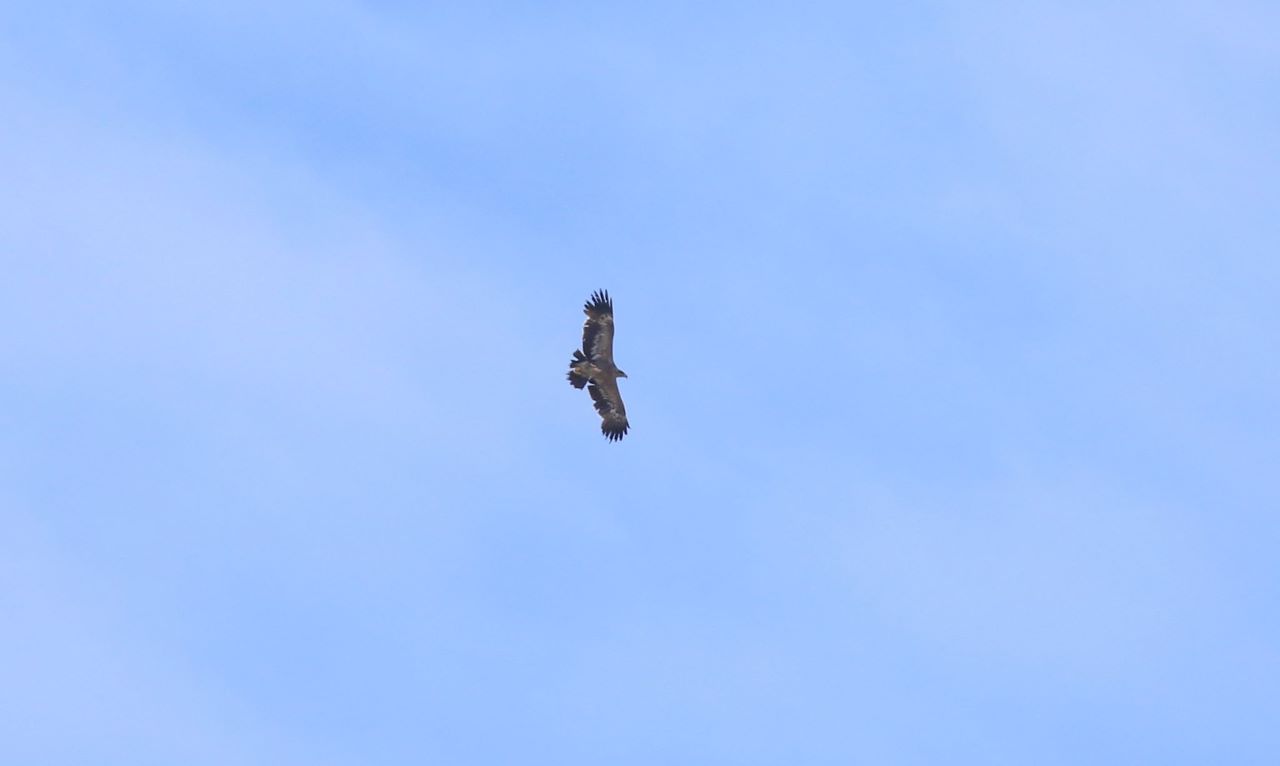
But not only did he see the steppe eagle but he was also lucky enough to see it right next to a lesser spotted eagle (lille skrigeørn) which is a very rare but wonderful opportunity to compare the two species.
In the afternoon first we had a visit from Martin, who works for Swarowski in Denmark and brought us a brand new pair of digital binoculars which we get to test over the next few weeks. We are really excited to see how they work and will report once we get a good impression!
After that we all went to Grenen in order to move a net to a different place and we also set up another net, so now we have a total of 23 nets out there. The new location is also more in the reeds so we might catch different species there. Tomorrow we will get to test it!
Ringing Jennes Sø:
Skovpiber – Tree Pipit – 1
Blåmejse – Blue Tit - 1
Gærdesmutte – Wren – 1
Gulbug – Icterine Warbler – 1
Solsort – Blackbird - 2
Munk – Blackcap – 2
Rødhals – Robin – 1
Gransanger – Chiffchaff -1
Total:10
People : Martina Hillbrand, Frederik R. Johansen and Amandine Doré
Klik her for at se dagens observationer indtastet i Dofbasen af observatører i området
Klik her for at se opsummeret observationer af rovfugle i Skagen
Newly hatched Crested tits (Topmejse ) in the net !
This morning, Martina and me went opening the nets, while Frederik enjoyed a little extra sleep and joined us for the first round. The weather conditions were very good - sunny weather, warm and not much wind - which is unfortunately also perfect for mosquitoes !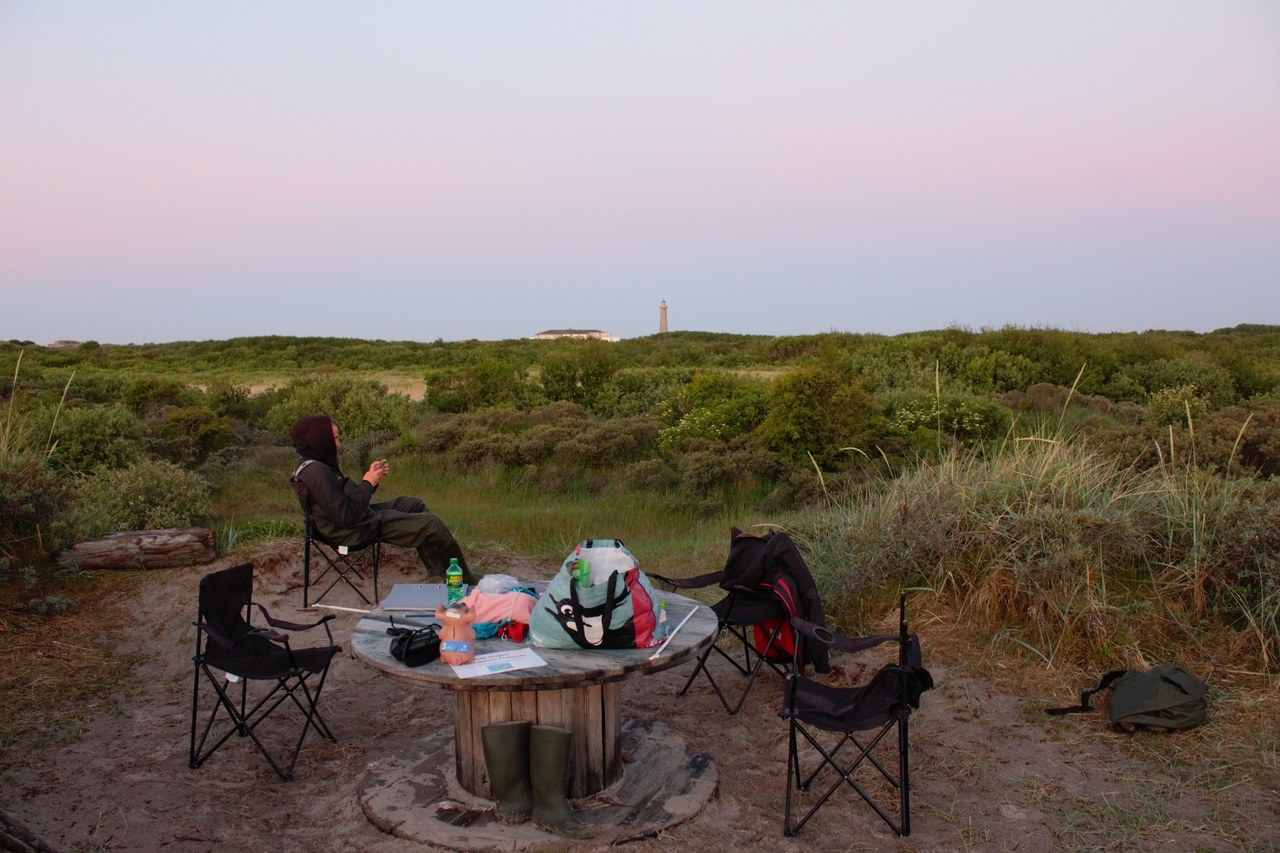
We caught more birds than we had these last few days. In our last rounds to the net, we caught 4 Crested tits (Topmejse), all of them likely born this year. This species is highly social and form small flocks, therefore it is not unusual to caught several of them in the nets.
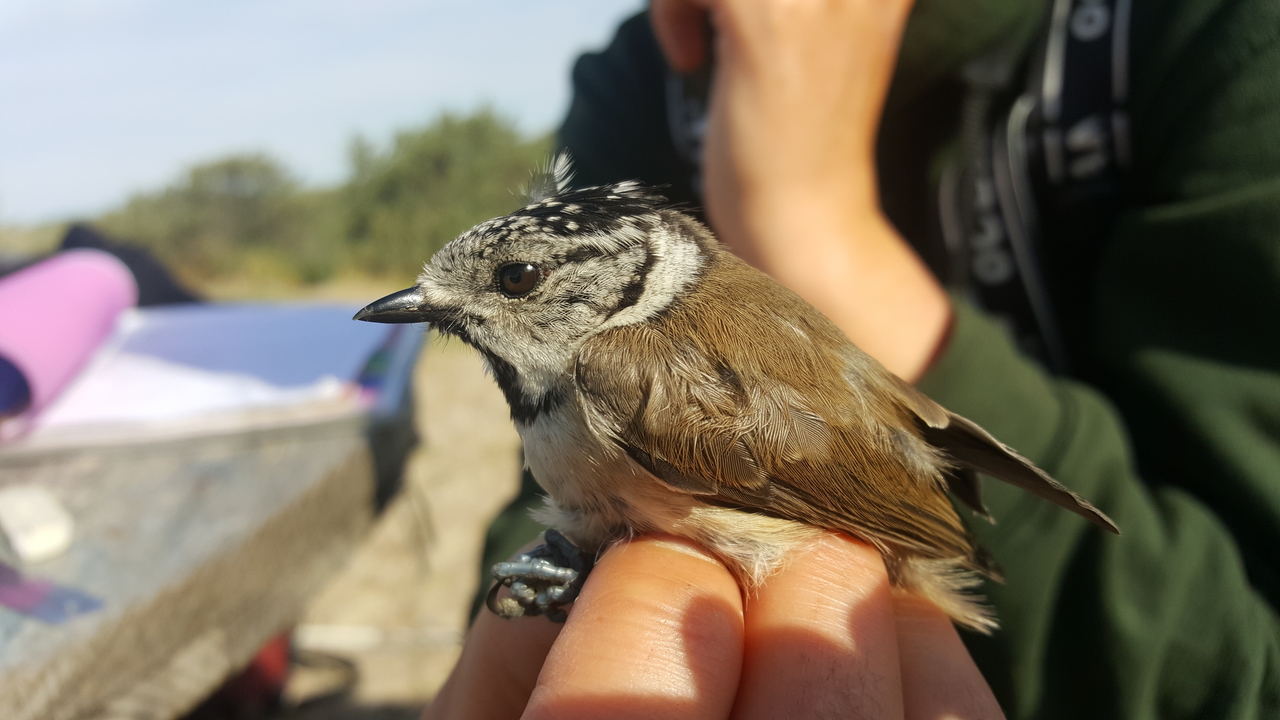
Ringmærkning (Kabeltromlen):
Gransanger – Chiffchaff - 1
Lille Dompap – Bullfinch – 1
Bogfinke – Chaffinch - 5
Havesanger – Garden Warbler - 1
Tornsanger – Common Whitethroat – 4
Munk – Blackcap – 13
Topmejse – Crested Tit – 3
Kærsanger – Marsh Warbler – 4
Rørsanger – Reed Warbler – 2
Sangdrossel – Song Thrush – 1
Gærdesmutte – Wren – 2
Gærdesanger – Lesser Whitehtroat – 2
Total: 39
People : Martina Hillbrandt, Frederik R. Johansen and Amandine Doré
Klik her for at se dagens observationer indtastet i Dofbasen af observatører i området
Rosenstær og Spurvehøg
I dag startede Amandine og jeg med at tage ud og åbne net. Senere kom Lars og hjalp til med ringmærkningen. Det gik godt i dag. Vi var nemlig så heldige at få lov til at ringmærke en Spurvehøg!

Klokken 0640 kom der en FLOOOOOT Rosenstær på trækforsøg. Det var dagens højdepunkt, for den er bare så lææækker!!

Amandine blev herhjemme og jeg tog ud at se på sommerfugle. Så en masse fede og smukke sommerfugle!
Her til aften kom Martina tilbage, og vi ser meget frem til de næste dage sammen med hende igen!
Ringmærkning (Kabeltromlen):
Spurvehøg - 1
Kærsanger - 2
Rørsanger - 2
Gulbug - 1
Gærdesanger - 2
Munk - 7
Lille Gråsisken - 3
Rørspurv - 1
Sum: 19
Klik her for at se dagens observationer indtastet i Dofbasen af observatører i området
Klik her for at se opsummeret observationer af rovfugle i Skagen
Folk: Amandine Doré, Lars Bo Jacobson, Thomas W. Johansen og Frederik Johansen.
